SAMSUNG PS50B850Y1W, PS50B855Y1W, PS58B685, PS58B685T6W, PS58B850Y1W User Manual
...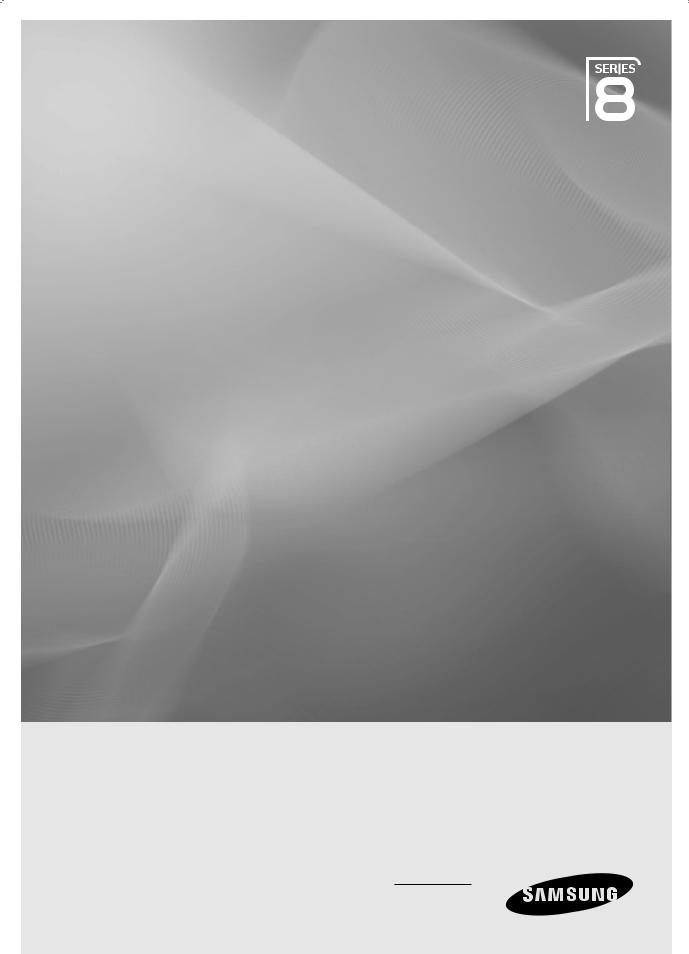
PDP TV
QUICK SETUP GUIDE
imagine the possibilities
Thank you for purchasing this Samsung product. To receive more complete service, please register your product at
www.samsung.com/register
Model |
|
Serial No. |
English -

The Supplied Accessoris
|
USB (E-manual) |
Remote Control/ |
Holder-Wire stand |
Warranty Card/ |
Quick Setup Guide |
||
|
|
AAA Batteries (2ea) |
|
|
|
Safety Guide Manual |
|
|
|
|
|
|
|
(Not available in all locations) |
|
|
|
|
|
|
|
|
|
|
|
|
|
|
|
|
|
|
|
|
|
|
|
|
|
|
|
|
|
|
|
|
|
Holder-Wire (3ea) |
Holder-Ring (4ea) |
Program-CD |
Cloth-Clean |
Holder-Wire Cable |
Ext Cable |
Component Cable |
AV Cable |
Cover-Bottom |
Cover-Bottom & Screw |
|
|
|
(PS50B850 only) |
(PS58B850 only) |
|
|
|
|
|
|
|
|
|
|
|
|
|
|
|
|
|
|
|
|
Screws (5ea) |
Ferrite Core (4ea) |
||||||||
(PS50B850 only) |
(3301-001305) |
||||||||
Installing Batteries in the Remote Control
Preparing before installing Wall-Mount
Case A. Installing the SAMSUNG Wall-Mount |
Case B. Installing another company’s Wall-Mount |
1.Install the Wall Mount with a torque range of 15kgf·cm or less. Use care as the parts can be damaged if the torque is out of the specified range.
2.Accessory Kit contains Holder–Ring [2] for installing another company’s Wall-Mount on Samsung TV. (Case B) Screw down the hole [1] when installing wall-mount on the wall.
English -
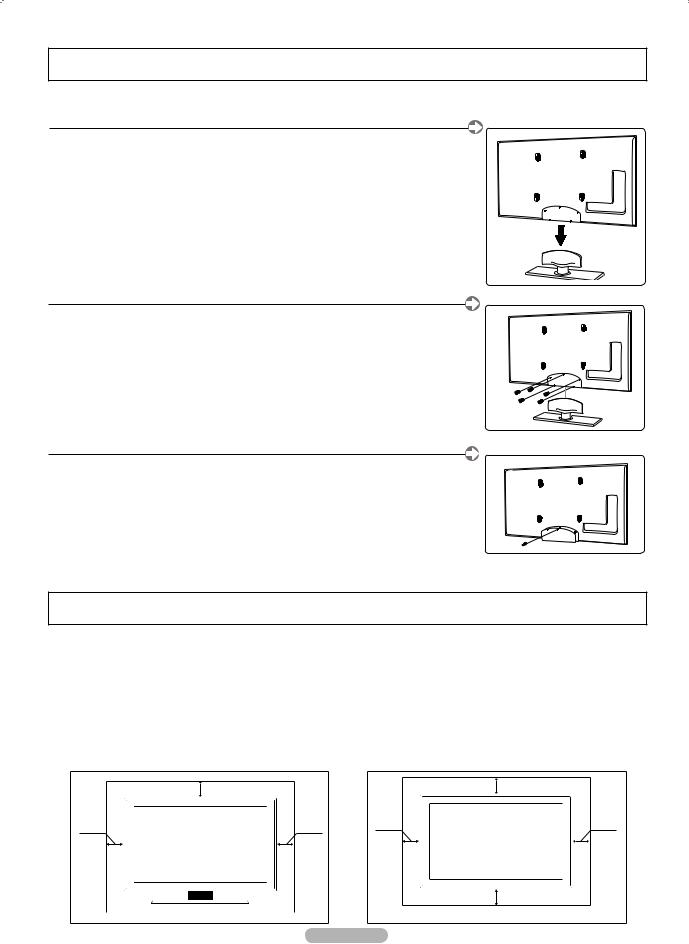
Installing the Stand
Warning
Firmly secure the stand to the TV before moving it, as the stand may fall and could cause serious injury.
1.Attach your PDP TV to the stand.
N Two or more people should carry the TV. Never lay the TV on the floor because of possible damage to the screen. Always store the TV upright.
N The product colour and shape may vary depending on the model.
2.Using the 5 screws for securing the stand base and the TV, firmly attach the TV to the stand
base.
NStand the product up and fasten the screws. If you fasten the screws with the PDP TV placed down, it may lean to one side.
3.When installing your TV on a wall, close the cover 1 on the stand-base connection using two
screws.

 1
1
Securing the Installation Space
Keep the required distances between the product and other objects (e.g. walls) to ensure proper ventilation.
Failing to do so may result in fire or a problem with the product due to an increase in the internal temperature of the product.
Install the product so the required distances shown in the figure are kept.
NWhen using a stand or wall-mount, use parts provided by Samsung Electronics only.
-If you use parts provided by another manufacturer, it may result in a problem with the product or an injury due to the product falling.
-If you use parts provided by another manufacturer, it may result in a problem with the product or fire due to an increase in the internal temperature of the product due to poor ventilation.
N The appearance may differ depending on the product.
When installing the product with a stand |
When installing the product with a wall-mount |
|
10 cm |
|
10 cm |
10 cm |
10 cm |
|
|
English - |
10 cm
10 cm
10 cm
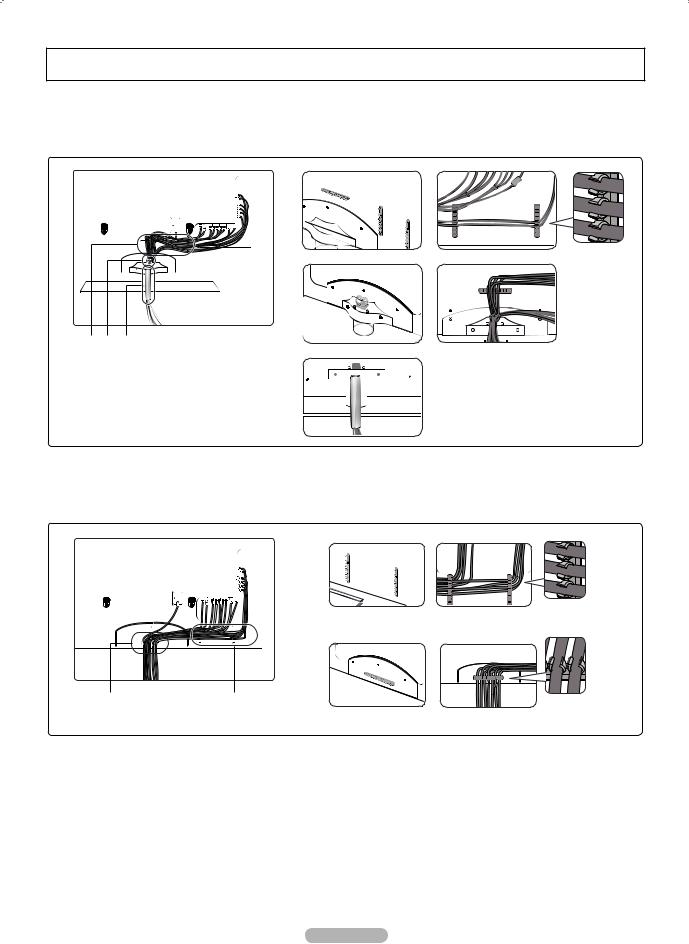
Assembling the Cables
Enclose the cables in the Holder-Wire Cable so that the cables are not visible through the transparent stand. N The product color and shape may vary depending on the model.
Stand Type
1
2
1 2 3
3 

1 Holder-Wire
2 Holder-Wire stand
3 Holder-Wire cable
NEnclose the cables in the Holder-Wire Cable so that the cables are not visible through the transparent stand.
Wall-Mount Type
1 
2
2 1
12 Holder-Wire
English -

Viewing the Menus
Before using the TV, follow the steps below to learn how to navigate the menu in order to select and adjust different functions.
MENU Button
Display the main on-screen menu.
▲/▼/◄/►/ENTERE Button  Move the cursor and select an item.
Move the cursor and select an item.
Select the currently selected item. Confirm the setting.
IN T ERN @ E T
RETURN Button
Return to the previous menu.
EXIT
Exit the on-screen menu.
Operation the OSD (On Screen Display)
The access step may differ depending on the selected menu.
1.Press the MENU button.
2.The main menu appears on the screen. The menu’s left side has icons : Picture, Sound,
Channel, Setup, Input, Application, Support.
Picture
Mode |
: Standard |
Cell Light |
: 7 |
Contrast |
: 95 |
Brightness |
: 45 |
Sharpness |
: 50 |
Colour |
: 50 |
Tint (G/R) |
: G50/R50 |
Advanced Settings |
|
3. Press the ▲ or ▼ button to select one of the icons.
4. Then press the ENTERE button to access the icon’s sub-menu.
IN T ERN @ E T
5.Press the ▲ or ▼ button to select the icon’s submenu.
Picture
Cell Light |
: 7 |
Contrast |
: 95 |
Brightness |
: 45 |
Sharpness |
: 50 |
Colour |
: 50 |
Tint (G/R) |
: G50/R50 |
Advanced Settings |
|
Picture Options |
|
Picture Reset |
|
6.Press the ◄ or ► button to decrease or increase the value of a particular item. The adjustment
OSD may differ depending on the selected menu.
7.Press the ENTERE button to complete the configuration.
8.Press the EXIT button to exit.
▲
Brightness 
 45
45
▼
Move |
Adjust |
Enter |
Return |
English -

Plug & Play
When the TV is initially powered on, basic settings proceed automatically and subsequently. N Preset: Connecting the mains and antenna.
When the TV is initially powered on, basic settings proceed automatically and subsequently.
NThe Screen Saver is activated if there is no remote control key input for longer than 1 minute while Plug & Play is running.
N The Screen Saver is activated if there is no operating signal for longer than 15 minutes.
NIf you accidentally select the wrong country for your TV, the characters on the screen may be wrongly displayed.
1.Press the POWER button on the remote control. Select the OSD Language. menu is automatically displayed. Select the appropriate language by pressing the ▲ or ▼ button. Press the ENTERE button to confirm your choice.
2.Press the ◄ or ► button to select Store Demo or Home Use, then the ENTERE button.
N We recommend setting the TV to Home Use mode for the best picture in your home environment.
N Store Demo mode is only intended for use in retail environments.
Plug & Play
SelecttheOSDLanguage |
English |
MenuLanguage |
Español |
|
Français |
|
U Move E Enter |
NIf the unit is accidentally set to Store Demo mode and you want to return to Home Use (Standard): Press the Volume button on the TV. When the volume OSD is displayed, press and hold the MENU button on the TV for 5 seconds.
3.Press the ENTERE button.
Select the appropriate country by pressing the ▲ or ▼ button. Press the ENTERE button to confirm your choice.
4.Press the ▲ or ▼ button to memorize the channels of the selected connection, then press the ENTERE button.
•Air : Air antenna signal.
•Cable : Cable antenna signal.
5.Press the ▲ or ▼ button to select the Antenna source to memorize.
Press the ENTERE button to select Start.
•Digital & Analogue : Digital and Analogue channels.
•Digital : Digital channels.
•Analogue : Analogue channels.
N The channel search will start and end automatically.
NFor more detailed description of selecting Cable mode, refer to Auto Store chapter.
6.The message Set the Clock Mode is displayed.
Press the ENTERE button.
Press the ▲ or ▼ button to select Auto, then Press the ENTERE button.
NIf you select Manual, Set current date and time is displayed.
(For a more detailed description of Manual, refer to the Setting the Time chapter)
NIf you have received a digital signal, the time will be set automatically.
7.The brief instruction on How to get the best performance from your new HDTV is displayed. Press the ENTERE button.
This menu is available HD Connection Guide in the Support menu.
8.The message Enjoy your TV. is displayed.
When you have finished, press the ENTERE button.
If you want to reset this feature...
1.Press the MENU button to display the menu. Press the ▲ or ▼ button to select Setup, then press the ENTERE button.
2.Press the ENTERE button again to select Plug & Play.
3.Enter your 4 digit PIN number. The default PIN number of a new TV set is ‘0-0-0-0’.
N If you want to change PIN number, refer to Change PIN chapter.
N The Plug & Play feature is only available in the TV mode.
English -
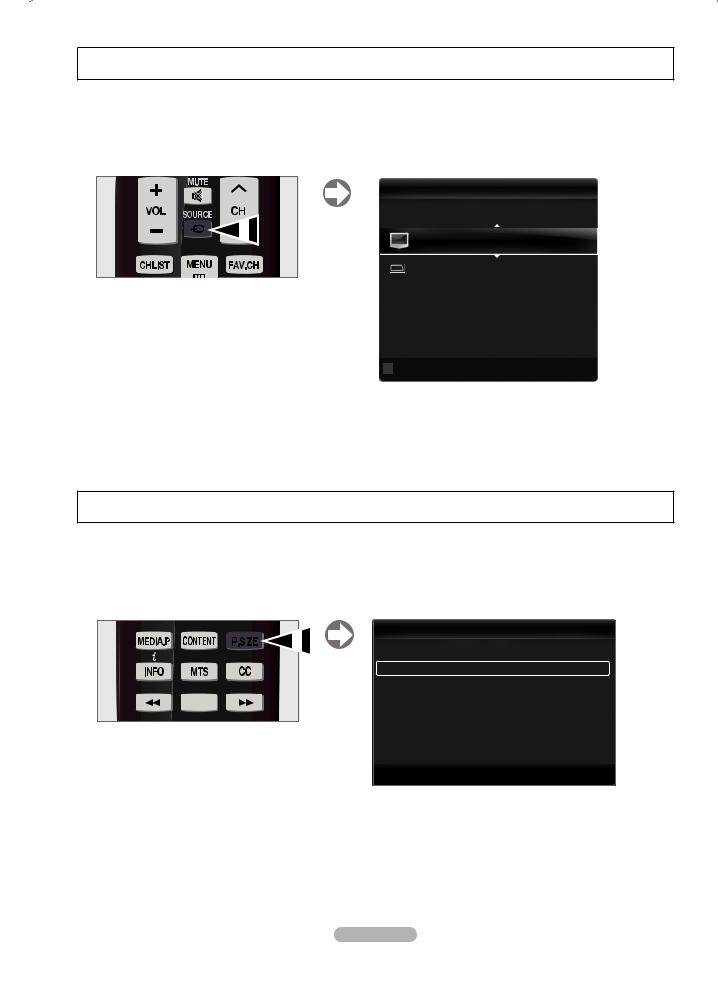
To Select the Source
Press the SOURCE button on the Remote Control. You can select the TV mode or an input source connected to the TV set. Use this button to choose an input source that you would like to watch.
N TV, Ext.1, Ext.2, AV, Component, PC, HDMI1/DVI, HDMI2I, HDMI3, HDMI4, USB.
N For more information, refer to the E-manual.
[N*a
Nzx{zypy *
PLa9<= E*8*8*8*8
***]pq}p~s*****T*_zzw~
Setting the Screen Size
If you want to change the size of the image on your screen. Press the MENU button to display the menu. You can set the picture size by selecting Picture → Picture Options → Size. Press the ▲ or ▼ button to select the screen format you want. (16:9 / Zoom1 / Zoom2 / Wide
Fit / 4:3 / Just Scan)
O Alternately, you can press the P.SIZE button on the remote control repeatedly to change the picture size.
Picture Options
|
|
|
|
Color Tone |
: Normal |
|
|
|
|
|
|
||
|
|
|
|
Size |
: 16:9 |
|
|
|
|
|
Screen Mode |
: 16:9 |
|
|
|
|
|
Digital NR |
: Auto |
|
|
|
|
||||
|
|
|
|
HDMI Black Level |
: Normal |
|
|
|
|
|
1080 Full HD Motion Demo |
: Off |
|
|
|
|
|
Film Mode |
: Off |
|
|
|
|
|
▼ |
E Enter |
R Return |
|
|
|
|
U Move |
English -
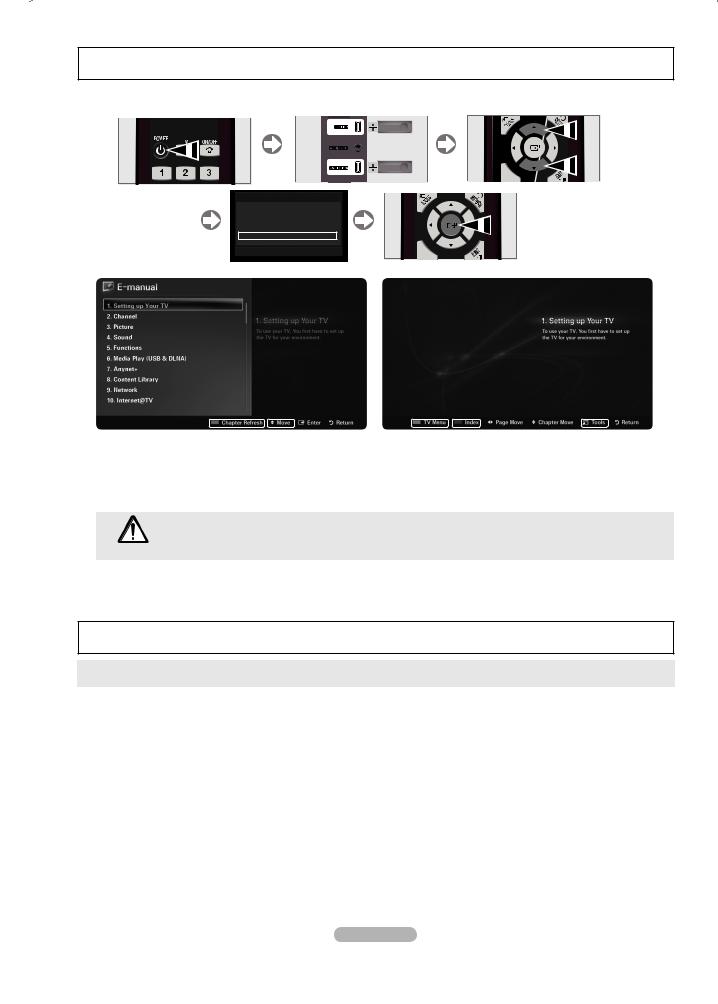
Installing the USB Memory Drive to view the e-manual
Viewing the Menus
Newportabledeviceconnection
Newportabledeviceconnection
Device:MemoRive
MediaPlay
ContentsLibrary
E-manual
SoftwareUpgrade
UMove EEnter RReturn
Screen Display
1 2
1.Refresh the chapter window
2.Move to selected menu.
IN T ER @N ET
IN T ER @N ET
3 |
4 |
5 |
3.Move to TV OSD menu.
4.Use the index menu.
5.View the E-manual.
Caution: using USB(E-manual)Use only for E-manual
To use for other purposes may cause malfunction.
Caution
Troubleshooting
Problem |
Solution |
|
|
|
|
When the e-manual isn’t operated promptly |
Check the USB connection status on TV. |
|
|
|
|
When the manual on the USB is deleted |
Connect to www.samsung.com |
|
|
|
|
|
Check that the mains lead has been connected to a wall socket. |
|
No sound or picture |
Check that you have pressed the button on your set. |
|
Check the picture contrast and brightness settings. |
||
|
||
|
Check the volume. |
|
|
|
|
|
Check the volume. |
|
Normal picture but no sound |
Check whether the MUTEM button has been pressed on the remote control. |
|
|
Check the Speaker Select settings. |
|
|
|
English -
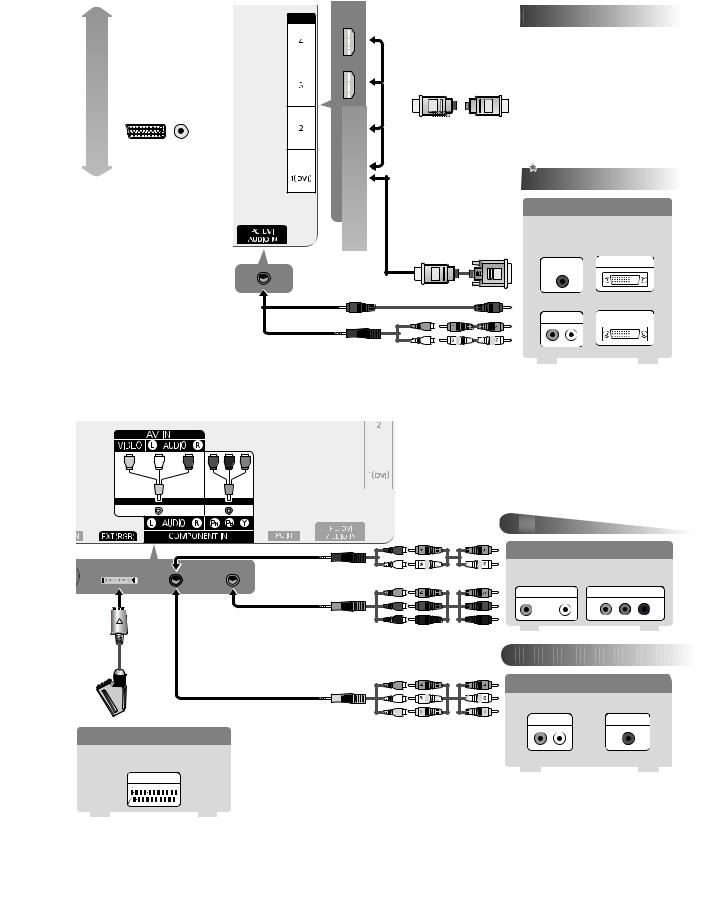
Connecting a AV device
N The product color and
 shape may vary depending on the model.
shape may vary depending on the model.
Best
Normal
 /
/

HDMI/DVI
 /
/


PC/COMPONENT
EXT/VIDEO
|
|
|
|
|
|
|
HD connection |
|
HDMI IN |
|
|||||||
|
|
|
|
|
|
|
Using a HDMI Cable |
|
|
|
|
|
|
|
|
|
|
|
|
|
|
|
|
|
DVD / Blu-Ray player / Cable Box |
|
|
|
|
|
|
||||
|
|
|
|
|
|
|
/ Satellite receiver (STB) |
|
|
|
|
|
|
|
|
HDMI OUT |
AU |
|
|
|
|
|
|
|
|
|
|
|
|
|
|
|
|
|
|
 HD connection
HD connection
Using an DVI Cable
DVD / Blu-Ray player / HD Cable
Box / HD Satellite receiver (STB)
AUDIO OUT DVI OUT
or
AUDIO OUT |
|
DVI OUT |
R |
W |
Y |
R |
W |
Y |
Component connection
Using a Component Cable
DVD / Blu-Ray player / Cable Box /
Satellite receiver
|
AUDIO OUT |
COMPONENT OUT |
B |
G |
||
|
R |
W |
R |
|
||
B |
B |
|
|
|
|
|
G |
G |
|
|
|
|
|
|
Audio/Video connection |
|
|
|||
|
|
|
R |
B |
G |
|
|
UsingRan Audio/VideoW |
Cable |
|
|
||
|
|
VCR |
|
|
|
|
|
AUDIO OUT |
|
VIDEO OUT |
|
|
|
Using a Scart Cable
VCR / DVD
EXT
English -
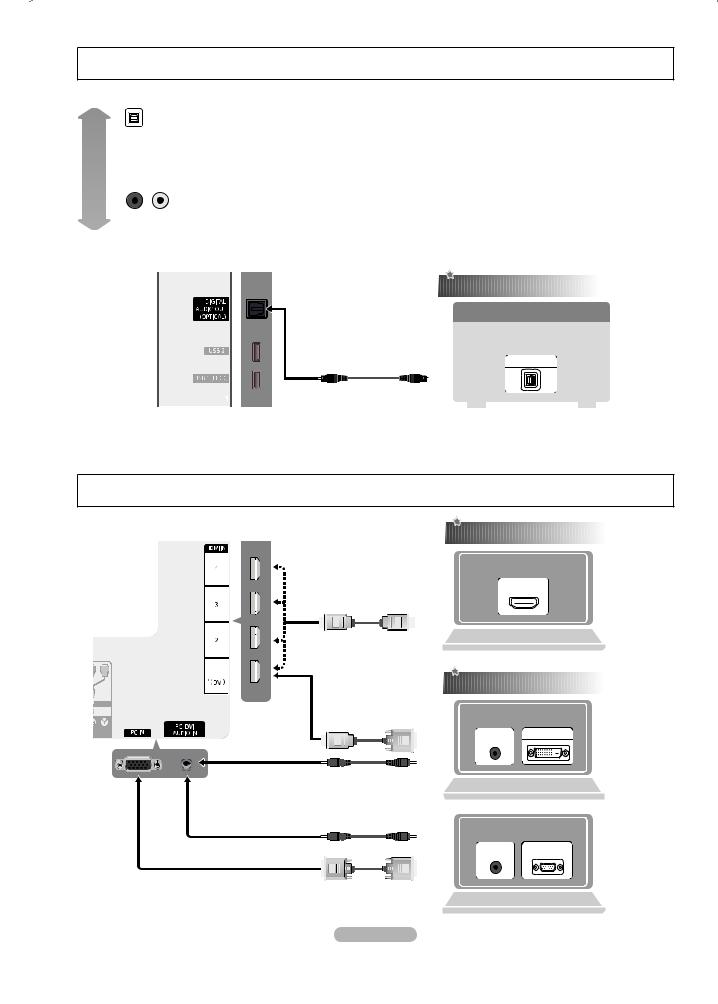
Connecting an audio device
N The product color and shape may vary depending on the model.
Normal Best
OPTICAL (Digital)
AUDIO (Analog)
 Digital Audio connection
Digital Audio connection
Using an Optical Cable
Digital Audio System
OPTICAL
Connecting a PC
N The product color and shape may vary depending on the model.
 HD connection
HD connection
Using an HDMI Cable
HDMI OUT
 HD connection
HD connection
Using an HDMI/DVI Cable
AUDIO OUT |
DVI OUT |
Using a D-Sub Cable
AUDIO OUT |
PC OUT |
English - 10

Software License
This product uses parts of the software from the Independent JPEG Group. This product uses parts of the software owned by the Freetype Project (www. freetype.org). This product uses some software programs which are distributed under the GPL/LGPL license. Accordingly, the following GPL and LGPL software source codes that have been used in this product can be provided after asking to vdswmanager@samsung.com. GPL software: Linux Kernel, Busybox, Binutils LGPL software: Glibc, ffmpeg, smpeg, libgphoto, libusb, SDL
GNU GENERAL PUBLIC LICENSE
GNU GENERAL PUBLIC LICENSE
Version 3, 29 June 2007
Copyright (C) 2007 Free Software Foundation, Inc. <http://fsf.org/> Everyone is permitted to copy and distribute verbatim copies of this license document, but changing it is not allowed.
Preamble
The GNU General Public License is a free, copyleft license for software and other kinds of works.
The licenses for most software and other practical works are designed to take away your freedom to share and change the works. By contrast, the GNU General Public License is intended to guarantee your freedom to share and change all versions of a program--to make sure it remains free software for all its users. We, the Free Software Foundation, use the GNU General Public License for most of our software; it applies also to any other work released this way by its authors.
You can apply it to your programs, too. When we speak of free software, we are referring to freedom, not price. Our General Public Licenses are designed to make sure that you have the freedom to distribute copies of free software (and charge for them if you wish), that you receive source code or can get it if you want it, that you can change the software or use pieces of it in new free programs, and that you know you can do these things. To protect your rights, we need to prevent others from denying you these rights or asking you to surrender the rights. Therefore, you have certain responsibilities if you distribute copies of the software, or if you modify it: responsibilities to respect the freedom of others. For example, if you distribute copies of such a program, whether gratis or for a fee, you must pass on to the recipients the same freedoms that you received. You must make sure that they, too, receive or can get the source code. And you must show them these terms so they know their rights. Developers that use the GNU GPL protect your rights with two steps: (1) assert copyright on the software, and
(2) offer you this License giving you legal permission to copy, distribute and/or modify it. For the developers’ and authors’ protection, the GPL clearly explains that there is no warranty for this free software. For both users’ and authors’ sake, the GPL requires that modified versions be marked as changed, so that their problems will not be attributed erroneously to authors of previous versions. Some devices are designed to deny users access to install or run modified versions of the software inside them, although the manufacturer can do so. This is fundamentally incompatible with the aim of protecting users’ freedom to change the software. The systematic pattern of such abuse occurs in the area of products for individuals to use, which is precisely where it is most unacceptable. Therefore, we have designed this version of the GPL to prohibit the practice for those products. If such problems arise substantially in other domains, we stand ready to extend this provision to those domains in future versions of the GPL, as needed to protect the freedom of users. Finally, every program is threatened constantly by software patents. States should not allow patents to restrict development and use of software on general-purpose computers, but in those that do, we wish to avoid the special danger that patents applied to a free program could make it effectively proprietary. To prevent this, the GPL assures that patents cannot be used to render the program non-free. The precise terms and conditions for copying, distribution and modification follow.
TERMS AND CONDITIONS
0.Definitions.
“This License” refers to version 3 of the GNU General Public License.
“Copyright” also means copyright-like laws that apply to other kinds of works, such as semiconductor masks.
“The Program” refers to any copyrightable work licensed under this License. Each licensee is addressed as “you”. “Licensees” and “recipients” may be individuals or organizations.
To “modify” a work means to copy from or adapt all or part of the work in a fashion requiring copyright permission, other than the making of an exact copy. The resulting work is called a “modified version” of the earlier work or a work “based on” the earlier work.
A “covered work” means either the unmodified Program or a work based on the Program.
To “propagate” a work means to do anything with it that, without permission, would make you directly or secondarily liable for infringement under applicable copyright law, except executing it on a computer or modifying a private copy. Propagation includes copying, distribution (with or without modification), making available to the public, and in some countries other activities as well.
To “convey” a work means any kind of propagation that enables other parties to make or receive copies. Mere interaction with a user through a computer network, with no transfer of a copy, is not conveying.
An interactive user interface displays “Appropriate Legal Notices” to the extent that it includes a convenient and prominently visible feature that (1) displays an appropriate copyright notice, and (2) tells the user that there is no warranty for the work (except to the extent that warranties are provided), that licensees may convey the work under this License, and how to view a copy of this License. If the interface presents a list of user commands or options, such as a menu, a prominent item in the list meets this criterion.
1.Source Code.
The “source code” for a work means the preferred form of the work for making modifications to it. “Object code” means any nonsource form of a work.
A “Standard Interface” means an interface that either is an official standard defined by a recognized standards body, or, in the case of interfaces specified for a particular programming language, one that is widely used among developers working in that language.
The “System Libraries” of an executable work include anything, other than the work as a whole, that (a) is included in the normal form of packaging a Major Component, but which is not part of that Major Component, and (b) serves only to enable use of the work with that Major Component, or to implement a Standard Interface for which an implementation is available to the public in source code form. A “Major Component”, in this context, means a major essential component (kernel, window system, and so on) of the specific operating system (if any) on which the executable work runs, or a compiler used to produce the work, or an object code interpreter used to run it.
The “Corresponding Source” for a work in object code form means all the source code needed to generate, install, and (for an executable work) run the object code and to modify the work, including scripts to control those activities. However, it does not include the work’s System Libraries, or generalpurpose tools or generally available free programs which are used unmodified in performing those activities but which are not part of the work. For example, Corresponding Source includes interface definition files associated with source files for the work, and the source code for shared libraries and dynamically linked subprograms that the work is specifically designed to require, such as by intimate data communication or control flow between those subprograms and other parts of the work.
The Corresponding Source need not include anything that users can regenerate automatically from other parts of the Corresponding Source. The Corresponding Source for a work in source code form is that same work.
English - 11

2.Basic Permissions.
All rights granted under this License are granted for the term of copyright on the Program, and are irrevocable provided the stated conditions are met. This License explicitly affirms your unlimited permission to run the unmodified Program. The output from running a covered work is covered by this License only if the output, given its content, constitutes a covered work. This License acknowledges your rights of fair use or other equivalent, as provided by copyright law. You may make, run and propagate covered works that you do not convey, without conditions so long as your license otherwise remains in force. You may convey covered works to others for the sole purpose of having them make modifications exclusively for you, or provide you with facilities for running those works, provided that you comply with the terms of this License in conveying all material for which you do not control copyright. Those thus making or running the covered works for you must do so exclusively on your behalf, under your direction and control, on terms that prohibit them from making any copies of your copyrighted material outside their relationship with you.
Conveying under any other circumstances is permitted solely under the conditions stated below. Sublicensing is not allowed; section 10 makes it unnecessary.
3.Protecting Users’ Legal Rights From Anti-Circumvention Law.
No covered work shall be deemed part of an effective technological measure under any applicable law fulfilling obligations under article 11 of the WIPO copyright treaty adopted on 20 December 1996, or similar laws prohibiting or restricting circumvention of such measures. When you convey a covered work, you waive any legal power to forbid circumvention of technological measures to the extent such circumvention is effected by exercising rights under this License with respect to the covered work, and you disclaim any intention to limit operation or modification of the work as a means of enforcing, against the work’s users, your or third parties’ legal rights to forbid circumvention of technological measures.
4.Conveying Verbatim Copies.
You may convey verbatim copies of the Program’s source code as you receive it, in any medium, provided that you conspicuously and appropriately publish on each copy an appropriate copyright notice; keep intact all notices stating that this License and any nonpermissive terms added in accord with section 7 apply to the code; keep intact all notices of the absence of any warranty; and give all recipients a copy of this License along with the Program.
You may charge any price or no price for each copy that you convey, and you may offer support or warranty protection for a fee.
5.Conveying Modified Source Versions.
You may convey a work based on the Program, or the modifications to produce it from the Program, in the form of source code under the terms of section 4, provided that you also meet all of these conditions:
a)The work must carry prominent notices stating that you modified it, and giving a relevant date.
b)The work must carry prominent notices stating that it is released under this License and any conditions added under section 7. This requirement modifies the requirement in section 4 to “keep intact all notices”.
c)You must license the entire work, as a whole, under this License to anyone who comes into possession of a copy. This License will therefore apply, along with any applicable section 7 additional terms, to the whole of the work, and all its parts, regardless of how they are packaged. This License gives no permission to license the work in any other way, but it does not invalidate such permission if you have separately received it.
d)If the work has interactive user interfaces, each must display Appropriate Legal Notices; however, if the Program has interactive interfaces that do not display Appropriate Legal Notices, your work need not make them do so.
A compilation of a covered work with other separate and independent works, which are not by their nature extensions of the covered work, and which are not combined with it such as to form a larger program, in or on a volume of a storage or distribution medium, is called an “aggregate” if the
compilation and its resulting copyright are not used to limit the access or legal rights of the compilation’s users beyond what the individual works permit. Inclusion of a covered work in an aggregate does not cause this License to apply to the other parts of the aggregate.
6.Conveying Non-Source Forms.
You may convey a covered work in object code form under the terms of sections 4 and 5, provided that you also convey the machinereadable Corresponding Source under the terms of this License, in one of these ways:
a)Convey the object code in, or embodied in, a physical product (including a physical distribution medium), accompanied by the Corresponding Source fixed on a durable physical medium customarily used for software interchange.
b)Convey the object code in, or embodied in, a physical product (including a physical distribution medium), accompanied by a written offer, valid for at least three years and valid for as long as you offer spare parts or customer support for that product model, to give anyone who possesses the object code either (1) a copy of the Corresponding Source for all the software in the product that is covered by this License, on a durable physical medium customarily used for software interchange, for a price no more than your reasonable cost of physically performing this conveying of source, or (2) access to copy the Corresponding Source from a network server at no charge.
c)Convey individual copies of the object code with a copy of the written offer to provide the Corresponding Source. This alternative is allowed only occasionally and noncommercially, and only if you received the object code with such an offer, in accord with subsection 6b.
d)Convey the object code by offering access from a designated place (gratis or for a charge), and offer equivalent access to the Corresponding Source in the same way through the same place at no further charge. You need not require recipients to copy the Corresponding Source along with the object code. If the place to copy the object code is a network server, the Corresponding Source may be on a different server (operated by you or a third party) that supports equivalent copying facilities, provided you maintain clear directions next to the object code saying where to find the Corresponding Source. Regardless of what server hosts the Corresponding Source, you remain obligated to ensure that it is available for as long as needed to satisfy these requirements.
e)Convey the object code using peer-to-peer transmission, provided you inform other peers where the object code and Corresponding Source of the work are being offered to the general public at no charge under subsection 6d. A separable portion of the object code, whose source code is excluded from
the Corresponding Source as a System Library, need not be included in conveying the object code work.
A “User Product” is either (1) a “consumer product”, which means any tangible personal property which is normally used for personal, family, or household purposes, or (2) anything designed or sold for incorporation into a dwelling. In determining whether a product is a consumer product, doubtful cases shall be resolved in favor of coverage. For a particular product received by a particular user, “normally used” refers to a typical or common use of that class
of product, regardless of the status of the particular user or of the way in which the particular user actually uses, or expects or is expected to use, the product. A product is a consumer product regardless of whether the product has substantial commercial, industrial or non-consumer uses, unless such uses represent the only significant mode of use of the product. “Installation Information” for a User Product means any methods, procedures, authorization keys, or other information required to install and execute modified versions of a covered work in that User Product from a modified version of its Corresponding Source. The information must suffice to ensure that the continued functioning of the modified object code is in no case prevented or interfered with solely because modification has been made. If you convey an object code work under this section in, or with, or specifically for use in, a User Product, and the conveying occurs as part of a transaction in which the right of possession and use of the User Product is transferred to the recipient in perpetuity or for
a fixed term (regardless of how the transaction is characterized), the Corresponding Source conveyed under this section must be accompanied by the
Installation Information. But this requirement does not apply if neither you nor any third party retains the ability to install modified object code on the User Product (for example, the work has been installed in ROM). The requirement to provide Installation Information does not include a requirement to continue to provide support service, warranty, or updates for a work that has been modified or installed by the recipient, or for the User Product in which it has been
English - 12

modified or installed. Access to a network may be denied when the modification itself materially and adversely affects the operation of the network or violates the rules and protocols for communication across the network. Corresponding Source conveyed, and Installation Information provided, in accord with this section must be in a format that is publicly documented (and with an implementation available to the public in source code form), and must require no special password or key for unpacking, reading or copying.
7.Additional Terms.
“Additional permissions” are terms that supplement the terms of this License by making exceptions from one or more of its conditions. Additional permissions that are applicable to the entire Program shall be treated as though they were included in this License, to the extent that they are valid under applicable law. If additional permissions apply only to part of the Program, that part may be used separately under those permissions, but the entire Program remains governed by this License without regard to the additional permissions.
When you convey a copy of a covered work, you may at your option remove any additional permissions from that copy, or from any part of it. (Additional permissions may be written to require their own removal in certain cases when you modify the work.) You may place additional permissions on material, added by you to a covered work, for which you have or can give appropriate copyright permission. Notwithstanding any other provision of this License, for material you add to a covered work, you may (if authorized by the copyright holders of that material) supplement the terms of this License with terms:
a)Disclaiming warranty or limiting liability differently from the terms of sections 15 and 16 of this License; or
b)Requiring preservation of specified reasonable legal notices or author attributions in that material or in the Appropriate Legal Notices displayed by works containing it; or
c)Prohibiting misrepresentation of the origin of that material, or requiring that modified versions of such material be marked in reasonable ways as different from the original version; or
d)Limiting the use for publicity purposes of names of licensors or authors of the material; or
e)Declining to grant rights under trademark law for use of some trade names, trademarks, or service marks; or
f)Requiring indemnification of licensors and authors of that material by anyone who conveys the material (or modified versions of it) with contractual
assumptions of liability to the recipient, for any liability that these contractual assumptions directly impose on those licensors and authors.
All other non-permissive additional terms are considered “further restrictions” within the meaning of section 10. If the Program as you received it, or any part of it, contains a notice stating that it is governed by this License along with a term that is a further restriction, you may remove that term. If a license document contains a further restriction but permits relicensing or conveying under this License, you may add to a covered work material governed by the terms of that license document, provided that the further restriction does not survive such relicensing or conveying.
If you add terms to a covered work in accord with this section, you must place, in the relevant source files, a statement of theadditional terms that apply to those files, or a notice indicating where to find the applicable terms. Additional terms, permissive or non-permissive, may be stated in the form of a separately written license, or stated as exceptions; the above requirements apply either way.
8.Termination.
You may not propagate or modify a covered work except as expressly provided under this License. Any attempt otherwise to propagate or modify it is void, and will automatically terminate your rights under this License (including any patent licenses granted under the third paragraph of section 11).
However, if you cease all violation of this License, then your license from a particular copyright holder is reinstated (a) provisionally, unless and until the copyright holder explicitly and finally terminates your license, and (b) permanently, if the copyright holder fails to notify you of the violation by some
reasonable means prior to 60 days after the cessation. Moreover, your license from a particular copyright holder is reinstated permanently if the copyright holder notifies you of the violation by some reasonable means, this is the first time you have received notice of violation of this License (for any work) from that copyright holder, and you cure the violation prior to 30 days after your receipt of the notice.
Termination of your rights under this section does not terminate the licenses of parties who have received copies or rights from you under this License. If your rights have been terminated and not permanently reinstated, you do not qualify to receive new licenses for the same material under section 10.
9.Acceptance Not Required for Having Copies.
You are not required to accept this License in order to receive or run a copy of the Program. Ancillary propagation of a covered work occurring solely as a consequence of using peer-to-peer transmission to receive a copy likewise does not require acceptance.
However, nothing other than this License grants you permission to propagate or modify any covered work. These actions infringe copyright if you do not accept this License. Therefore, by modifying or propagating a covered work, you indicate your acceptance of this License to do so.
10.Automatic Licensing of Downstream Recipients.
Each time you convey a covered work, the recipient automatically receives a license from the original licensors, to run, modify and propagate that work, subject to this License. You are not responsible for enforcing compliance by third parties with this License.
An “entity transaction” is a transaction transferring control of an organization, or substantially all assets of one, or subdividing an organization, or merging organizations. If propagation of a covered work results from an entity transaction, each party to that transaction who receives a copy of the work also receives whatever licenses to the work the party’s predecessor in interest had or could give under the previous paragraph, plus a right to possession of the You may not impose any further restrictions on the exercise of the rights granted or affirmed under this License. For example, you may not impose a license fee, royalty, or other charge for exercise of rights granted under this License, and you may not initiate litigation (including a cross-claim or counterclaim in a lawsuit) alleging that any patent claim is infringed by making, using, selling, offering for sale, or importing the Program or any portion of it.
11.Patents.
A “contributor” is a copyright holder who authorizes use under this License of the Program or a work on which the Program is based.
The work thus licensed is called the contributor’s “contributor version”.
A contributor’s “essential patent claims” are all patent claims owned or controlled by the contributor, whether already acquired or hereafter acquired, that would be infringed by some manner, permitted by this License, of making, using, or selling its contributor version, but do not include claims that would be infringed only as a consequence of further modification of the contributor version.
For purposes of this definition, “control” includes the right to grant patent sublicenses in a manner consistent with the requirements of this License.
Each contributor grants you a non-exclusive, worldwide, royalty-free patent license under the contributor’s essential patent claims, to make, use, sell, offer for sale, import and otherwise run, modify and propagate the contents of its contributor version. In the following three paragraphs, a “patent license” is any express agreement or commitment, however denominated, not to enforce a patent (such as an express permission to practice a patent or covenant not to sue for patent infringement). To “grant” such a patent license to a party means to make such an agreement or commitment not to enforce a patent against the party.
If you convey a covered work, knowingly relying on a patent license, and the Corresponding Source of the work is not available for anyone to copy, free of charge and under the terms of this License, through a publicly available network server or other readily accessible means, then you must either (1) cause the Corresponding Source to be so available, or (2) arrange to deprive yourself of the benefit of the patent license for this particular work, or (3) arrange, in a manner consistent with the requirements of this License, to extend the patent license to downstream recipients. “Knowingly relying” means you have actual knowledge that, but for the patent license, your conveying the covered work in a country, or your recipient’s use of the covered work in a country, would infringe one or more identifiable patents in that country that you have reason to believe are valid.
English - 13

If, pursuant to or in connection with a single transaction or arrangement, you convey, or propagate by procuring conveyance of, a covered work, and grant a patent license to some of the parties receiving the covered work authorizing them to use, propagate, modify or convey a specific copy of the covered work, then the patent license you grant is automatically extended to all recipients of the covered work and works based on it.
A patent license is “discriminatory” if it does not include within the scope of its coverage, prohibits the exercise of, or is conditioned on the non-exercise of one or more of the rights that are specifically granted under this License. You may not convey a covered work if you are a party to an arrangement with a third party that is in the business of distributing software, under which you make payment to the third party based on the extent of your activity of conveying the work, and under which the third party grants, to any of the parties who would receive the covered work from you, a discriminatory patent license (a)
in connection with copies of the covered work conveyed by you (or copies made from those copies), or (b) primarily for and in connection with specific products or compilations that contain the covered work, unless you entered into that arrangement, or that patent license was granted, prior to 28 March 2007.
Nothing in this License shall be construed as excluding or limiting any implied license or other defenses to infringement that may otherwise be available to you under applicable patent law.
12.No Surrender of Others’ Freedom.
If conditions are imposed on you (whether by court order, agreement or otherwise) that contradict the conditions of this License, they do not excuse you from the conditions of this License. If you cannot convey a covered work so as to satisfy simultaneously your obligations under this License and any other pertinent obligations, then as a consequence you may not convey it at all. For example, if you agree to terms that obligate you to collect a royalty for further conveying from those to whom you convey the Program, the only way you could satisfy both those terms and this License would be to refrain entirely from conveying the Program.
13.Use with the GNU Affero General Public License.
Notwithstanding any other provision of this License, you have permission to link or combine any covered work with a work licensed under version 3 of the GNU Affero General Public License into a single combined work, and to convey the resulting work. The terms of this License will continue to apply to the part which is the covered work, but the special requirements of the GNU Affero General
Public License, section 13, concerning interaction through a network will apply to the combination as such.
14.Revised Versions of this License.
The Free Software Foundation may publish revised and/or new versions of the GNU General Public License from time to time. Such new versions will be similar in spirit to the present version, but may differ in detail to address new problems or concerns.
Each version is given a distinguishing version number. If the Program specifies that a certain numbered version of the GNU General Public License “or any later version” applies to it, you have the option of following the terms and conditions either of that numbered version or of any later version published by the Free Software Foundation. If the Program does not specify a version number of the GNU General Public License, you may choose any version ever published by the Free Software Foundation.
If the Program specifies that a proxy can decide which future versions of the GNU General Public License can be used, that proxy’s public statement of acceptance of a version permanently authorizes you to choose that version for the Program.
Later license versions may give you additional or different permissions. However, no additional obligations are imposed on any author or copyright holder as a result of your choosing to follow a later version.
15.Disclaimer of Warranty.
THERE IS NO WARRANTY FOR THE PROGRAM, TO THE EXTENT PERMITTED BY APPLICABLE LAW. EXCEPT WHEN OTHERWISE STATED IN WRITING THE COPYRIGHT HOLDERS AND/OR OTHER PARTIES PROVIDE THE PROGRAM “AS IS” WITHOUT WARRANTY OF ANY KIND, EITHER EXPRESSED OR IMPLIED, INCLUDING, BUT NOT LIMITED TO, THE IMPLIED WARRANTIES OF MERCHANTABILITY AND FITNESS FOR A PARTICULAR PURPOSE. THE ENTIRE RISK AS TO THE QUALITY AND PERFORMANCE OF THE PROGRAM IS WITH YOU. SHOULD THE PROGRAM PROVE DEFECTIVE, YOU ASSUME THE COST OF ALL NECESSARY SERVICING, REPAIR OR CORRECTION.
16. Limitation of Liability.
IN NO EVENT UNLESS REQUIRED BY APPLICABLE LAW OR AGREED TO IN WRITING WILL ANY COPYRIGHT HOLDER, OR ANY OTHER PARTY WHO MODIFIES AND/OR CONVEYS THE PROGRAM AS PERMITTED ABOVE, BE LIABLE TO YOU FOR DAMAGES, INCLUDING ANY GENERAL, SPECIAL, INCIDENTAL OR CONSEQUENTIAL DAMAGES ARISING OUT OF THE USE OR INABILITY TO USE THE PROGRAM (INCLUDING BUT NOT LIMITED TO LOSS OF DATA OR DATA BEING RENDERED INACCURATE OR LOSSES SUSTAINED BY YOU OR THIRD PARTIES OR A FAILURE OF THE PROGRAM TO OPERATE WITH ANY OTHER PROGRAMS), EVEN IF SUCH HOLDER OR OTHER PARTY HAS BEEN ADVISED OF THE POSSIBILITY OF SUCH DAMAGES.
17. Interpretation of Sections 15 and 16.
If the disclaimer of warranty and limitation of liability provided above cannot be given local legal effect according to their terms, reviewing courts shall apply local law that most closely approximates an absolute waiver of all civil liability in connection with the Program, unless a warranty or assumption of liability accompanies a copy of the Program in return for a fee.
How to Apply These Terms to Your New Programs
If you develop a new program, and you want it to be of the greatest possible use to the public, the best way to achieve this is to make it free software which everyone can redistribute and change under these terms. To do so, attach the following notices to the program. It is safest to attach them to the start of each
source file to most effectively state theexclusion of warranty; and each file should have at least the “copyright” line and a pointer to where the full notice is found. <one line to give the program’s name and a brief idea of what it does.> Copyright (C) <year> <name of author>
This program is free software: you can redistribute it and/or modify it under the terms of the GNU General Public License as published by the Free Software Foundation, either version 3 of the License, or (at your option) any later version.
This program is distributed in the hope that it will be useful, but WITHOUT ANY WARRANTY; without even the implied warranty of MERCHANTABILITY or FITNESS FOR A PARTICULAR PURPOSE. See the GNU General Public License for more details.
You should have received a copy of the GNU General Public License along with this program. If not, see <http://www.gnu.org/licenses/>. Also add information on how to contact you by electronic and paper mail.
If the program does terminal interaction, make it output a short notice like this when it starts in an interactive mode:
<program> Copyright (C) <year> <name of author> This program comes with ABSOLUTELY NO WARRANTY; for details type `show w’. This is free software, and you are welcome to redistribute it under certain conditions; type `show c’ for details.
The hypothetical commands `show w’ and `show c’ should show the appropriate parts of the General Public License. Of course, your program’s commands might be different; for a GUI interface, you would use an “about box”.
You should also get your employer (if you work as a programmer) or school, if any, to sign a “copyright disclaimer” for the program, if necessary.
For more information on this, and how to apply and follow the GNU GPL, see <http://www.gnu.org/licenses/>.The GNU General Public License does not permit incorporating your program into proprietary programs. If your program is a subroutine library, you may consider it more useful to permit linking proprietary
applications with the library. If this is what you want to do, use the GNU Lesser General Public License instead of this License. But first, please read <http://www. gnu.org/philosophy/why-not-lgpl.html>.
English - 14

GNU Lesser General Public License (LGPL)
GNU GENERAL PUBLIC LICENSE
Version 3, 29 June 2007
Copyright (C) 2007 Free Software Foundation, Inc. <http://fsf.org/>
Everyone is permitted to copy and distribute verbatim copies of this license document, but changing it is not allowed.
Preamble
The GNU General Public License is a free, copyleft license for software and other kinds of works.
The licenses for most software and other practical works are designed to take away your freedom to share and change the works. By contrast, the GNU General Public License is intended to guarantee your freedom to share and change all versions of a program--to make sure it remains free software for all its users. We, the Free Software Foundation, use the GNU General Public License for most of our software; it applies also to any other work released this way by its authors.
You can apply it to your programs, too.
When we speak of free software, we are referring to freedom, not price. Our General Public Licenses are designed to make sure that you have the freedom to distribute copies of free software (and charge for them if you wish), that you receive source code or can get it if you want it, that you can change the software or use pieces of it in new free programs, and that you know you can do these things.
To protect your rights, we need to prevent others from denying you these rights or asking you to surrender the rights. Therefore, you have certain responsibilities if you distribute copies of the software, or if you modify it: responsibilities to respect the freedom of others.
For example, if you distribute copies of such a program, whether gratis or for a fee, you must pass on to the recipients the same freedoms that you received. You must make sure that they, too, receive or can get the source code. And you must show them these terms so they know their rights.
Developers that use the GNU GPL protect your rights with two steps: (1) assert copyright on the software, and (2) offer you this License giving you legal permission to copy, distribute and/or modify it.
For the developers’ and authors’ protection, the GPL clearly explains that there is no warranty for this free software. For both users’ and authors’ sake, the GPL requires that modified versions be marked as changed, so that their problems will not be attributed erroneously to authors of previous versions.
Some devices are designed to deny users access to install or run modified versions of the software inside them, although the manufacturer can do so. This is fundamentally incompatible with the aim of protecting users’ freedom to change the software. The systematic pattern of such abuse occurs in the area of products for individuals to use, which is precisely where it is most unacceptable. Therefore, we have designed this version of the GPL to prohibit the practice for those products. If such problems arise substantially in other domains, we stand ready to extend this provision to those domains in future versions of the
GPL, as needed to protect the freedom of users. Finally, every program is threatened constantly by software patents. States should not allow patents to restrict development and use of software on general-purpose computers, but in those that do, we wish to avoid the special danger that patents applied to a free program could make it effectively proprietary. To prevent this, the GPL assures that patents cannot be used to render the program non-free. The precise terms and conditions for copying, distribution and modification follow.
TERMS AND CONDITIONS
0.Definitions.
“This License” refers to version 3 of the GNU General Public License.
“Copyright” also means copyright-like laws that apply to other kinds of works, such as semiconductor masks.
“The Program” refers to any copyrightable work licensed under this License. Each licensee is addressed as “you”. “Licensees” and “recipients” may be individuals or organizations.
To “modify” a work means to copy from or adapt all or part of the work in a fashion requiring copyright permission, other than the making of an exact copy. The resulting work is called a “modified version” of the earlier work or a work “based on” the earlier work.
A “covered work” means either the unmodified Program or a work based on the Program.
To “propagate” a work means to do anything with it that, without permission, would make you directly or secondarily liable for infringement under applicable copyright law, except executing it on a computer or modifying a private copy. Propagation includes copying, distribution (with or without modification), making available to the public, and in some countries other activities as well.
To “convey” a work means any kind of propagation that enables other parties to make or receive copies. Mere interaction with a user through a computer network, with no transfer of a copy, is not conveying.
An interactive user interface displays “Appropriate Legal Notices” to the extent that it includes a convenient and prominently visible feature that (1) displays an appropriate copyright notice, and (2) tells the user that there is no warranty for the work (except to the extent that warranties are provided), that licensees may convey the work under this License, and how to view a copy of this License. If the interface presents a list of user commands or options, such as a menu, a prominent item in the list meets this criterion.
1.Source Code.
The “source code” for a work means the preferred form of the work for making modifications to it. “Object code” means any nonsource form of a work.
A “Standard Interface” means an interface that either is an official standard defined by a recognized standards body, or, in the case of interfaces specified for a particular programming language, one that is widely used among developers working in that language. The “System Libraries” of an executable work include anything, other than the work as a whole, that (a) is included in the normal form of packaging a Major Component, but which is not part of that Major Component, and (b) serves only to enable use of the work with that Major Component, or to implement a Standard Interface for which an implementation
is available to the public in source code form. A “Major Component”, in this context, means a major essential component (kernel, window system, and so on) of the specific operating system (if any) on which the executable work runs, or a compiler used to produce the work, or an object code interpreter used to run it. The “Corresponding Source” for a work in object code form means all the source code needed to generate, install, and (for an executable work) run the object code and to modify the work, including scripts to control those activities. However, it does not include the work’s System Libraries, or
general-purpose tools or generally available free programs which are used unmodified in performing those activities but which are not part of the work. For example, Corresponding Source includes interface definition files associated with source files for the work, and the source code for shared libraries and dynamically linked subprograms that the work is specifically designed to require, such as by intimate data communication or control flow between those subprograms and other parts of the work. The Corresponding Source need not include anything that users can regenerate automatically from other parts of the Corresponding Source. The Corresponding Source for a work in source code form is that same work.
2.Basic Permissions.
All rights granted under this License are granted for the term of copyright on the Program, and are irrevocable provided the stated conditions are met. This License explicitly affirms your unlimited permission to run the unmodified Program. The output from running a covered work is covered by this License only if the output, given its content, constitutes a covered work. This License acknowledges your rights of fair use or other equivalent, as provided by copyright law. You may make, run and propagate covered works that you do not convey, without conditions so long as your license otherwise remains in force. You may convey covered works to others for the sole purpose of having them make modifications exclusively for you, or provide you with facilities for running those works, provided that you comply with the terms of this License in conveying all material for which you do not control copyright. Those thus making or running the covered works for you must do so exclusively on your behalf, under your direction and control, on terms that prohibit them from making any
English - 15

copies of your copyrighted material outside their relationship with you. Conveying under any other circumstances is permitted solely under the conditions stated below. Sublicensing is not allowed; section 10 makes it unnecessary.
3.Protecting Users’ Legal Rights From Anti-Circumvention Law.
No covered work shall be deemed part of an effective technological measure under any applicable law fulfilling obligations under article 11 of the WIPO copyright treaty adopted on 20 December 1996, or similar laws prohibiting or restricting circumvention of such measures. When you convey a covered work, you waive any legal power to forbid circumvention of technological measures to the extent such circumvention is effected by exercising rights under this License with respect to the covered work, and you disclaim any intention to limit operation or modification of the work as a means of enforcing, against the work’s users, your or third parties’ legal rights to forbid circumvention of technological measures.
4.Conveying Verbatim Copies.
You may convey verbatim copies of the Program’s source code as you receive it, in any medium, provided that you conspicuously and appropriately publish on each copy an appropriate copyright notice; keep intact all notices stating that this License and any nonpermissive terms added in accord with section
7 apply to the code; keep intact all notices of the absence of any warranty; and give all recipients a copy of this License along with the Program. You may charge any price or no price for each copy that you convey, and you may offer support or warranty protection for a fee.
5.Conveying Modified Source Versions. You may convey a work based on the Program, or the modifications to produce it from the Program, in the form of source code under the terms of section 4, provided that you also meet all of these conditions:
a)The work must carry prominent notices stating that you modified it, and giving a relevant date.
b)The work must carry prominent notices stating that it is released under this License and any conditions added under section 7. This requirement modifies the requirement in section 4 to “keep intact all notices”.
c)You must license the entire work, as a whole, under this License to anyone who comes into possession of a copy. This License will therefore apply, along with any applicable section 7 additional terms, to the whole of the work, and all its parts, regardless of how they are packaged. This License gives no permission to license the work in any other way, but it does not invalidate such permission if you have separately received it.
d)If the work has interactive user interfaces, each must display Appropriate Legal Notices; however, if the Program has interactive interfaces that do not
display Appropriate Legal Notices, your work need not make them do so.
A compilation of a covered work with other separate and independent works, which are not by their nature extensions of the covered work, and which are not combined with it such as to form a larger program, in or on a volume of a storage or distribution medium, is called an “aggregate” if the compilation and its resulting copyright are not used to limit the access or legal rights of the compilation’s users beyond what the individual works permit. Inclusion of a covered work in an aggregate does not cause this License to apply to the other parts of the aggregate.
6.Conveying Non-Source Forms.
You may convey a covered work in object code form under the terms of sections 4 and 5, provided that you also convey the machinereadable Corresponding Source under the terms of this License, in one of these ways:
a)Convey the object code in, or embodied in, a physical product (including a physical distribution medium), accompanied by the Corresponding Source fixed on a durable physical medium customarily used for software interchange.
b)Convey the object code in, or embodied in, a physical product (including a physical distribution medium), accompanied by a written offer, valid for at least three years and valid for as long as you offer spare parts or customer support for that product model, to give anyone who possesses the object code either (1) a copy of the Corresponding Source for all the software in the product that is covered by this License, on a durable physical medium customarily used for software interchange, for a price no more than your reasonable cost of physically performing this conveying of source, or (2) access to copy the Corresponding Source from a network server at no charge.
c)Convey individual copies of the object code with a copy of the written offer to provide the Corresponding Source. This alternative is allowed only occasionally and noncommercially, and only if you received the object code with such an offer, in accord with subsection 6b.
d)Convey the object code by offering access from a designated place (gratis or for a charge), and offer equivalent access to the Corresponding Source in the same way through the same place at no further charge. You need not require recipients to copy the Corresponding Source along with the object code. If the place to copy the object code is a network server, the Corresponding Source may be on a different server (operated by you or a third party) that supports equivalent copying facilities, provided you maintain clear directions next to the object code saying where to find the Corresponding Source. Regardless of what server hosts the Corresponding Source, you remain obligated to ensure that it is available for as long as needed to satisfy these requirements.
e)Convey the object code using peer-to-peer transmission, provided you inform other peers where the object code and Corresponding Source of the work are being offered to the general public at no charge under subsection 6d. A separable portion of the object code, whose source code is excluded from
the Corresponding Source as a System Library, need not be included in conveying the object code work.
A “User Product” is either (1) a “consumer product”, which means any tangible personal property which is normally used for personal, family, or household purposes, or (2) anything designed or sold for incorporation into a dwelling. In determining whether a product is a consumer product, doubtful cases shall be resolved in favor of coverage. For a particular product received by a particular user, “normally used” refers to a typical or common use of that class
of product, regardless of the status of the particular user or of the way in which the particular user actually uses, or expects or is expected to use, the product. A product is a consumer product regardless of whether the product has substantial commercial, industrial or non-consumer uses, unless such uses represent the only significant mode of use of the product. “Installation Information” for a User Product means any methods, procedures, authorization keys, or other information required to install and execute modified versions of a covered work in that User Product from a modified version of its Corresponding Source. The information must suffice to ensure that the continued functioning of the modified object code is in no case prevented or interfered with solely because modification has been made. If you convey an object code work under this section in, or with, or specifically for use in, a User Product, and the conveying occurs as part of a transaction in which the right of possession and use of the User Product is transferred to the recipient in perpetuity or for
a fixed term (regardless of how the transaction is characterized), the Corresponding Source conveyed under this section must be accompanied by the
Installation Information. But this requirement does not apply if neither you nor any third party retains the ability to install modified object code on the User Product (for example, the work has been installed in ROM). The requirement to provide Installation Information does not include a requirement to continue to provide support service, warranty, or updates for a work that has been modified or installed by the recipient, or for the User Product in which it has been modified or installed. Access to a network may be denied when the modification itself materially and adversely affects the operation of the network or violates the rules and protocols for communication across the network. Corresponding Source conveyed, and Installation Information provided, in accord with this section must be in a format that is publicly documented (and with an implementation available to the public in source code form), and must require no special password or key for unpacking, reading or copying.
7.Additional Terms.
“Additional permissions” are terms that supplement the terms of this License by making exceptions from one or more of its conditions. Additional permissions that are applicable to the entire Program shall be treated as though they were included in this License, to the extent that they are valid under applicable law. If additional permissions apply only to part of the Program, that part may be used separately under those permissions, but the entire Program remains governed by this License without regard to the additional permissions.
When you convey a copy of a covered work, you may at your option remove any additional permissions from that copy, or from any part of it. (Additional
English - 16

permissions may be written to require their own removal in certain cases when you modify the work.) You may place additional permissions on material, added by you to a covered work, for which you have or can give appropriate copyright permission. Notwithstanding any other provision of this License, for material you add to a covered work, you may (if authorized by the copyright holders of that material) supplement the terms of this License with terms:
a)Disclaiming warranty or limiting liability differently from the terms of sections 15 and 16 of this License; or
b)Requiring preservation of specified reasonable legal notices or author attributions in that material or in the Appropriate Legal Notices displayed by works containing it; or
c)Prohibiting misrepresentation of the origin of that material, or requiring that modified versions of such material be marked in reasonable ways as different from the original version; or
d)Limiting the use for publicity purposes of names of licensors or authors of the material; or
e)Declining to grant rights under trademark law for use of some trade names, trademarks, or service marks; or
f)Requiring indemnification of licensors and authors of that material by anyone who conveys the material (or modified versions of it) with contractual
assumptions of liability to the recipient, for any liability that these contractual assumptions directly impose on those licensors and authors.
All other non-permissive additional terms are considered “further restrictions” within the meaning of section 10. If the Program as you received it, or any part of it, contains a notice stating that it is governed by this License along with a term that is a further restriction, you may remove that term. If a license document contains a further restriction but permits relicensing or conveying under this License, you may add to a covered work material governed by the terms of that license document, provided that the further restriction does not survive such relicensing or conveying. If you add terms to a covered work in accord with this section, you must place, in the relevant source files, a statement of the additional terms that apply to those files, or a notice indicating where to find the applicable terms. Additional terms, permissive or non-permissive, may be stated in the form of a separately written license, or stated as exceptions; the above requirements apply either way.
8.Termination.
You may not propagate or modify a covered work except as expressly provided under this License. Any attempt otherwise to propagate or modify it is void, and will automatically terminate your rights under this License (including any patent licenses granted under the third paragraph of section 11). However, if you cease all violation of this License, then your license from a particular copyright holder is reinstated (a) provisionally, unless and until the copyright holder explicitly and finally terminates your license, and (b) permanently, if the copyright holder fails to notify you of the violation by some reasonable means prior to 60 days after the cessation. Moreover, your license from a particular copyright holder is reinstated permanently if the copyright holder notifies you of the violation by some reasonable means, this is the first time you have received notice of violation of this License (for any work) from that copyright holder, and you cure the violation prior to 30 days after your receipt of the notice. Termination of your rights under this section does not terminate the licenses of parties who have received copies or rights from you under this License. If your rights have been terminated and not permanently reinstated, you do not qualify to receive new licenses for the same material under section 10.
9.Acceptance Not Required for Having Copies.
You are not required to accept this License in order to receive or run a copy of the Program. Ancillary propagation of a covered work occurring solely as a consequence of using peer-to-peer transmission to receive a copy likewise does not require acceptance. However, nothing other than this License grants you permission to propagate or modify any covered work. These actions infringe copyright if you do not accept this License. Therefore, by modifying or propagating a covered work, you indicate your acceptance of this License to do so.
10.Automatic Licensing of Downstream Recipients.
Each time you convey a covered work, the recipient automatically receives a license from the original licensors, to run, modify and propagate that work, subject to this License. You are not responsible for enforcing compliance by third parties with this License. An “entity transaction” is a transaction transferring control of an organization, or substantially all assets of one, or subdividing an organization, or merging organizations. If propagation of a
covered work results from an entity transaction, each party to that transaction who receives a copy of the work also receives whatever licenses to the work the party’s predecessor in interest had or could give under the previous paragraph, plus a right to possession of the Corresponding Source of the work from the predecessor in interest, if the predecessor has it or can get it with reasonable efforts. You may not impose any further restrictions on the exercise of the rights granted or affirmed under this License. For example, you may not impose a license fee, royalty, or other charge for exercise of rights granted under this License, and you may not initiate litigation (including a cross-claim or counterclaim in a lawsuit) alleging that any patent claim is infringed by making, using, selling, offering for sale, or importing the Program or any portion of it.
11.Patents.
A “contributor” is a copyright holder who authorizes use under this License of the Program or a work on which the Program is based. The work thus licensed is called the contributor’s “contributor version”. A contributor’s “essential patent claims” are all patent claims owned or controlled by the contributor, whether already acquired or hereafter acquired, that would be infringed by some manner, permitted by this License, of making, using, or selling its contributor version, but do not include claims that would be infringed only as a consequence of further modification of the contributor version. For purposes of this definition, “control” includes the right to grant patent sublicenses in a manner consistent with the requirements of this License. Each contributor grants
you a non-exclusive, worldwide, royalty-free patent license under the contributor’s essential patent claims, to make, use, sell, offer for sale, import and otherwise run, modify and propagate the contents of its contributor version. In the following three paragraphs, a “patent license” is any express agreement or commitment, however denominated, not to enforce a patent (such as an express permission to practice a patent or covenant not to sue for patent infringement). To “grant” such a patent license to a party means to make such an agreement or commitment not to enforce a patent against the party. If you convey a covered work, knowingly relying on a patent license, and the Corresponding Source of the work is not available for anyone to copy, free of charge and under the terms of this License, through a publicly available network server or other readily accessible means, then you must either (1) cause the Corresponding Source to be so available, or (2) arrange to deprive yourself of the benefit of the patent license for this particular work, or (3) arrange, in a manner consistent with the requirements of this License, to extend the patent license to downstream recipients. “Knowingly relying” means you have actual knowledge that, but for the patent license, your conveying the covered work in a country, or your recipient’s use of the covered work in a country, would infringe one or more identifiable patents in that country that you have reason to believe are valid. If, pursuant to or in connection with a single transaction or arrangement, you convey, or propagate by procuring conveyance of, a covered work, and grant a patent license to some of the parties receiving the covered work authorizing them to use, propagate, modify or convey a specific copy of the covered work, then the patent license you grant is automatically extended to all recipients of the covered work and works based on it.
A patent license is “discriminatory” if it does not include within the scope of its coverage, prohibits the exercise of, or is conditioned on the non-exercise of one or more of the rights that are specifically granted under this License. You may not convey a covered work if you are a party to an arrangement with a third party that is in the business of distributing software, under which you make payment to the third party based on the extent of your activity of conveying the work, and under which the third party grants, to any of the parties who would receive the covered work from you, a discriminatory patent license (a)
in connection with copies of the covered work conveyed by you (or copies made from those copies), or (b) primarily for and in connection with specific products or compilations that contain the covered work, unless you entered into that arrangement, or that patent license was granted, prior to 28 March 2007.
Nothing in this License shall be construed as excluding or limiting any implied license or other defenses to infringement that may otherwise be available to you under applicable patent law.
English - 17

12.No Surrender of Others’ Freedom.
If conditions are imposed on you (whether by court order, agreement or otherwise) that contradict the conditions of this License, they do not excuse you from the conditions of this License. If you cannot convey a covered work so as to satisfy simultaneously your obligations under this License and any other pertinent obligations, then as a consequence you may not convey it at all. For example, if you agree to terms that obligate you to collect a royalty for further conveying from those to whom you convey the Program, the only way you could satisfy both those terms and this License would be to refrain entirely from conveying the Program.
13.Use with the GNU Affero General Public License.
Notwithstanding any other provision of this License, you have permission to link or combine any covered work with a work licensed under version 3 of the GNU Affero General Public License into a single combined work, and to convey the resulting work. The terms of this License will continue to apply to the part which is the covered work, but the special requirements of the GNU Affero General Public License, section 13, concerning interaction through a network will apply to the combination as such.
14.Revised Versions of this License.
The Free Software Foundation may publish revised and/or new versions of the GNU General Public License from time to time. Such new versions will be similar in spirit to the present version, but may differ in detail to address new problems or concerns. Each version is given a distinguishing version number. If the Program specifies that a certain numbered version of the GNU General Public License “or any later version” applies to it, you have the option of following the terms and conditions either of that numbered version or of any later version published by the Free Software Foundation. If the Program does not specify a version number of the GNU General Public License, you may choose any version ever published by the Free Software Foundation.
If the Program specifies that a proxy can decide which future versions of the GNU General Public License can be used, that proxy’s public statement of acceptance of a version permanently authorizes you to choose that version for the Program. Later license versions may give you additional or different permissions. However, no additional obligations are imposed on any author or copyright holder as a result of your choosing to follow a later version.
15.Disclaimer of Warranty.
THERE IS NO WARRANTY FOR THE PROGRAM, TO THE EXTENT PERMITTED BY APPLICABLE LAW. EXCEPT WHEN OTHERWISE STATED IN WRITING THE COPYRIGHT HOLDERS AND/OR OTHER PARTIES PROVIDE THE PROGRAM “AS IS” WITHOUT WARRANTY OF ANY KIND, EITHER EXPRESSED OR IMPLIED, INCLUDING, BUT NOT LIMITED TO, THE IMPLIED WARRANTIES OF MERCHANTABILITY AND FITNESS FOR A PARTICULAR PURPOSE. THE ENTIRE RISK AS TO THE QUALITY AND PERFORMANCE OF THE PROGRAM IS WITH YOU. SHOULD THE PROGRAM PROVE DEFECTIVE, YOU ASSUME THE COST OF ALL NECESSARY SERVICING, REPAIR OR CORRECTION.
16. Limitation of Liability.
IN NO EVENT UNLESS REQUIRED BY APPLICABLE LAW OR AGREED TO IN WRITING WILL ANY COPYRIGHT HOLDER, OR ANY OTHER PARTY WHO MODIFIES AND/OR CONVEYS THE PROGRAM AS PERMITTED ABOVE, BE LIABLE TO YOU FOR DAMAGES, INCLUDING ANY GENERAL, SPECIAL, INCIDENTAL OR CONSEQUENTIAL DAMAGES ARISING OUT OF THE USE OR INABILITY TO USE THE PROGRAM (INCLUDING BUT NOT LIMITED TO LOSS OF DATA OR DATA BEING RENDERED INACCURATE OR LOSSES SUSTAINED BY YOU OR THIRD PARTIES OR A FAILURE OF THE PROGRAM TO OPERATE WITH ANY OTHER PROGRAMS), EVEN IF SUCH HOLDER OR OTHER PARTY HAS BEEN ADVISED OF THE POSSIBILITY OF SUCH DAMAGES.
17. Interpretation of Sections 15 and 16.
If the disclaimer of warranty and limitation of liability provided above cannot be given local legal effect according to their terms, reviewing courts shall apply local law that most closely approximates an absolute waiver of all civil liability in connection with the Program, unless a warranty or assumption of liability accompanies a copy of the Program in return for a fee.
END OF TERMS AND CONDITIONS
How to Apply These Terms to Your New Programs
If you develop a new program, and you want it to be of the greatest possible use to the public, the best way to achieve this is to make it free software which everyone can redistribute and change under these terms. To do so, attach the following notices to the program. It is safest to attach them to the start of each source file to most effectively state the exclusion of warranty; and each file should have at least the “copyright” line and a pointer to where the full notice is found.
<one line to give the program’s name and a brief idea of what it does.> Copyright (C) <year> <name of author>
This program is free software: you can redistribute it and/or modify it under the terms of the GNU General Public License as published by the Free Software Foundation, either version 3 of the License, or (at your option) any later version.
This program is distributed in the hope that it will be useful, but WITHOUT ANY WARRANTY; without even the implied warranty of MERCHANTABILITY or FITNESS FOR A PARTICULAR PURPOSE. See the GNU General Public License for more details.
You should have received a copy of the GNU General Public License along with this program. If not, see <http://www.gnu.org/ licenses/>.
Also add information on how to contact you by electronic and paper mail.
If the program does terminal interaction, make it output a short notice like this when it starts in an interactive mode:
<program> Copyright (C) <year> <name of author> This program comes with ABSOLUTELY NO WARRANTY; for details type `show w’. This is free software, and you are welcome to redistribute it under certain conditions; type `show c’ for details.
The hypothetical commands `show w’ and `show c’ should show the appropriate parts of the General Public License. Of course, your program’s commands might be different; for a GUI interface, you would use an “about box”.
You should also get your employer (if you work as a programmer) or school, if any, to sign a “copyright disclaimer” for the program, if necessary. For more information on this, and how to apply and follow the GNU GPL, see <http://www.gnu.org/licenses/>.
The GNU General Public License does not permit incorporating your program into proprietary programs. If your program is a subroutine library, you may consider it more useful to permit linking proprietary applications with the library. If this is what you want to do, use the GNU Lesser General Public License instead of this License. But first, please read <http://www.gnu.org/philosophy/why-not-lgpl.html>.
The OpenSSL toolkit stays under a dual license, i.e. both the conditions of the OpenSSL License and the original SSLeay license apply to the toolkit. See below for the actual license texts. Actually both licenses are BSD-style Open Source licenses. In case of any license issues related to OpenSSL please contact openssl-core@openssl.org.
OpenSSL License
Copyright (c) 1998-2007 The OpenSSL Project. All rights reserved.
Redistribution and use in source and binary forms, with or without modification, are permitted provided that the following conditions are met:
1.Redistributions of source code must retain the above copyright notice, this list of conditions and the following disclaimer.
2.Redistributions in binary form must reproduce the above copyright notice, this list of conditions and the following disclaimer in the documentation and/or other materials provided with the distribution.
3.All advertising materials mentioning features or use of this software must display the following acknowledgment: “This product includes software developed
English - 18

by the OpenSSL Project for use in the OpenSSL Toolkit. (http://www.openssl.org/)”
4.The names “OpenSSL Toolkit” and “OpenSSL Project” must not be used to endorse or promote products derived from this software without prior written permission. For written permission, please contact openssl-core@openssl.org.
5.Products derived from this software may not be called “OpenSSL nor may “OpenSSL” appear in their names without prior written permission of the OpenSSL Project.
6.Redistributions of any form whatsoever must retain the following acknowledgment: “This product includes software developed by the OpenSSL Project for use in the OpenSSL Toolkit (http://www.openssl.org/)”
THIS SOFTWARE IS PROVIDED BY THE OpenSSL PROJECT ``AS IS’’ AND ANY EXPRESSED OR IMPLIED WARRANTIES, INCLUDING, BUT NOT LIMITED TO, THE IMPLIED WARRANTIES OF MERCHANTABILITY AND FITNESS FOR A PARTICULAR PURPOSE ARE DISCLAIMED. IN NO EVENT SHALL THE OpenSSL PROJECT OR ITS CONTRIBUTORS BE LIABLE FOR ANY DIRECT, INDIRECT, INCIDENTAL, SPECIAL, EXEMPLARY, OR CONSEQUENTIAL DAMAGES (INCLUDING, BUT NOT LIMITED TO, PROCUREMENT OF SUBSTITUTE GOODS OR SERVICES; LOSS OF USE, DATA, OR PROFITS; OR BUSINESS INTERRUPTION) HOWEVER CAUSED AND ON ANY THEORY OF LIABILITY, WHETHER IN CONTRACT, STRICT LIABILITY, OR TORT (INCLUDING NEGLIGENCE OR OTHERWISE) ARISING IN ANY WAY OUT OF THE USE OF THIS SOFTWARE, EVEN IF ADVISED OF THE POSSIBILITY OF SUCH DAMAGE.
This product includes cryptographic software written by Eric Young (eay@cryptsoft.com). This product includes software written by Tim Hudson (tjh@cryptsoft. com).
Original SSLeay License
Copyright (C) 1995-1998 Eric Young (eay@cryptsoft.com) All rights reserved.
This package is an SSL implementation written by Eric Young (eay@cryptsoft.com). The implementation was written so as to conform with Netscapes SSL. This library is free for commercial and non-commercial use as long as the following conditions are aheared to. The following conditions apply to all code found in
this distribution, be it the RC4, RSA, lhash, DES, etc., code; not just the SSL code. The SSL documentation included with this distribution is covered by the same copyright terms except that the holder is Tim Hudson (tjh@cryptsoft.com).
Copyright remains Eric Young’s, and as such any Copyright notices in the code are not to be removed. If this package is used in a product, Eric Young should be given attribution as the author of the parts of the library used. This can be in the form of a textual message at program startup or in documentation (online or textual) provided with the package.
Redistribution and use in source and binary forms, with or without modification, are permitted provided that the following conditions are met:
1.Redistributions of source code must retain the copyright notice, this list of conditions and the following disclaimer.
2.Redistributions in binary form must reproduce the above copyright notice, this list of conditions and the following disclaimer in the documentation and/or other materials provided with the distribution.
3.All advertising materials mentioning features or use of this software must display the following acknowledgement: “This product includes cryptographic software written by Eric Young (eay@cryptsoft.com)” The word ‘cryptographic’ can be left out if the rouines from the library being used are not cryptographic related :-).
4.If you include any Windows specific code (or a derivative thereof) from the apps directory (application code) you must include an acknowledgement: “This product includes software written by Tim Hudson (tjh@cryptsoft.com)”
THIS SOFTWARE IS PROVIDED BY ERIC YOUNG ``AS IS’’ AND ANY EXPRESS OR IMPLIED WARRANTIES, INCLUDING, BUT NOT LIMITED TO, THE IMPLIED WARRANTIES OF MERCHANTABILITY AND FITNESS FOR A PARTICULAR PURPOSE ARE DISCLAIMED. IN NO EVENT SHALL THE AUTHOR OR CONTRIBUTORS BE LIABLE FOR ANY DIRECT, INDIRECT, INCIDENTAL, SPECIAL, EXEMPLARY, OR CONSEQUENTIAL DAMAGES (INCLUDING, BUT NOT LIMITED TO, PROCUREMENT OF SUBSTITUTE GOODS OR SERVICES; LOSS OF USE, DATA, OR PROFITS; OR BUSINESS INTERRUPTION) HOWEVER CAUSED AND ON ANY THEORY OF LIABILITY, WHETHER IN CONTRACT, STRICT LIABILITY, OR TORT (INCLUDING NEGLIGENCE OR OTHERWISE) ARISING IN ANY WAY OUT OF THE USE OF THIS SOFTWARE, EVEN IF ADVISED OF THE POSSIBILITY OF SUCH DAMAGE.
The licence and distribution terms for any publically available version or derivative of this code cannot be changed. i.e. this code cannot simply be copied and put under another distribution licence [including the GNU Public Licence.]
English - 19
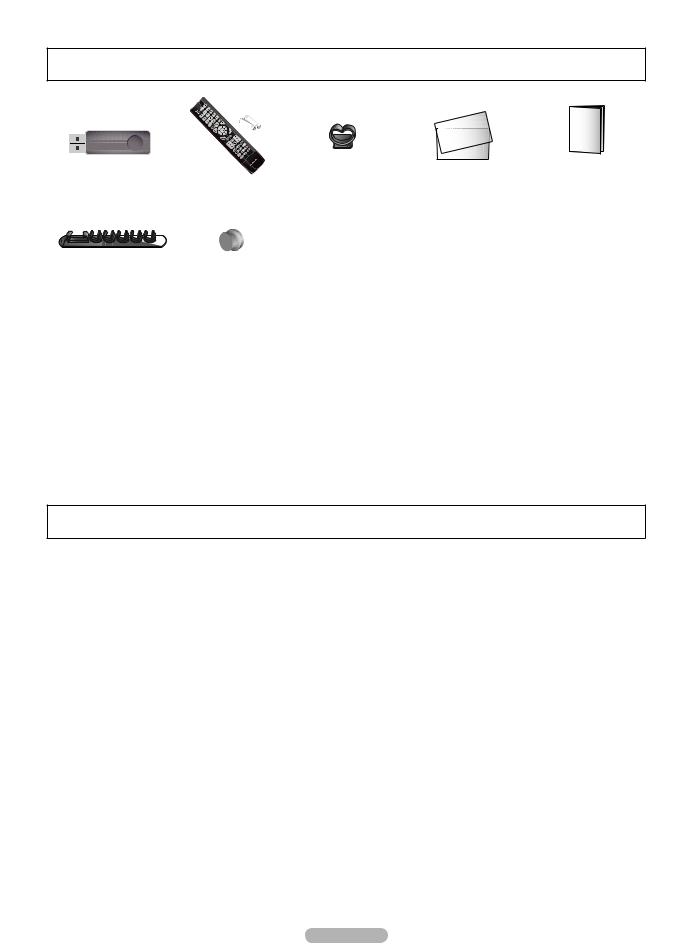
Accessoires fournis
Clé USB (manuel électronique) |
Télécommande/ |
Support du |
Carte de garantie/ |
Guide d’installation rapide |
|||
|
|
|
|
Piles AAA (2ea) |
serre-câble |
Manuel de sécurité |
|
|
|
|
|
|
(Non disponible dans tous les pays) |
|
|
|
|
|
|
|
|
|
|
|
|
|
|
|
|
|
|
|
|
|
|
|
|
|
|
|
|
|
|
|
|
|
|
Serre-câble (3ea) |
Anneau de support (4ea) |
CD du programme |
Chiffon de nettoyage |
Serre-câbles |
Câbles Ext |
Câble composant |
Câbles AV |
Capot inférieur |
Capot inférieur |
|
|
|
(PS50B850 uniquement) |
/ Vis (PS58B850 uniquement) |
|
|
|
|
|
|
|
|
|
|
|
|
|
|
|
|
|
|
|
|
|
Vis (5ea) |
Tore magnétique(4ea) |
|||||||
(PS50B850 uniquement) |
(3301-001305) |
||||||||
Insertion des piles dans la télécommande
Préparation avant l’installation d’un kit de fixation murale
Cas A. Installation d’un kit de fixation murale de SAMSUNG |
Cas B. Installation d’un kit de fixation murale d’un autre fabricant |
1.Installez le kit de fixation murale avec un couple de serrage de 15 kg/cm ou moins.
Certaines pièces peuvent être endommagées si le couple est supérieur.
2.Le kit d’accessoires contient un Support – un Anneau [2] en vue d’installer un kit d’une marque autre que Samsung TV. (Cas B)
Insérez la vis dans le trou [1] lors de l’installation de la fixation murale.
Français -
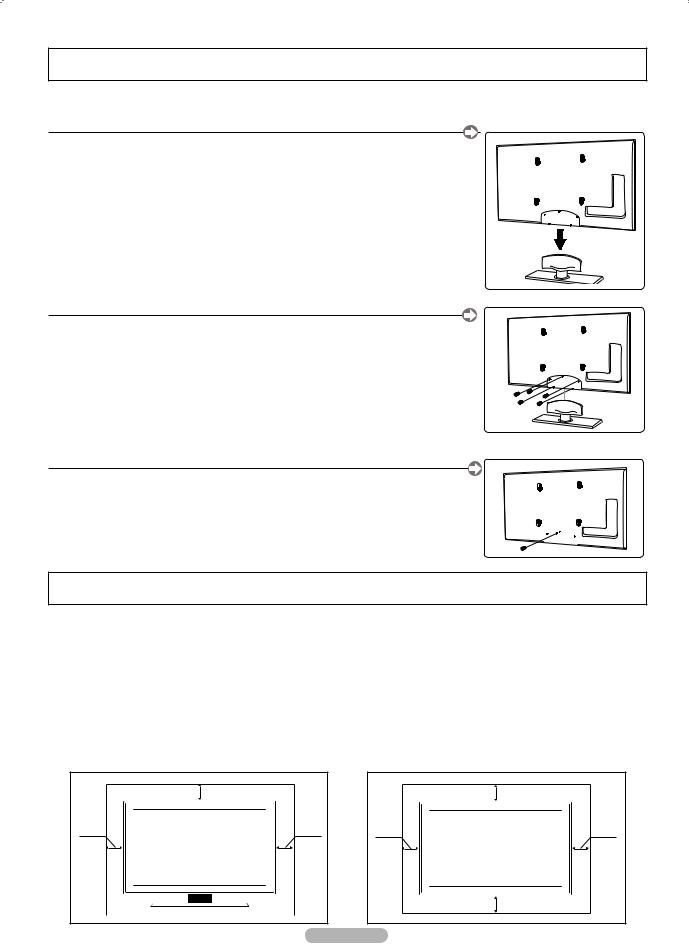
Montage du socle
Avertissement
Fixez fermement le socle au téléviseur avant de déplacer ce dernier. Il pourrait tomber et provoquer de graves dommages.
1.Fixez le téléviseur à écran plasma sur le socle.
N Le téléviseur doit être porté par au moins deux personnes. Ne posez jamais le téléviseur sur le sol : cela pourrait l’endommager. Conservez toujours le téléviseur en position verticale.
N La couleur et la forme du produit peuvent varier en fonction du modèle.
2.Au moyen des 2 vis permettant de solidariser la base-support et le moniteur, fixez fermement
le moniteur à la base-support.
NRedressez le produit et serrez les vis. Si vous serrez les vis alors que le téléviseur à écran plasma est à l’horizontale, il est possible qu’il penche d’un côté.
3.Lorsque vous fixez votre téléviseur au mur, installez le capot (1) sur la base-support à l’aide
de deux vis.
1
Sécurisation de l’emplacement d’installation
Respectez les distances requises entre le produit et d’autres objets (p. ex. murs) pour assurer une ventilation adéquate.
Le non-respect de cette consigne pourrait provoquer un incendie ou un problème avec le produit en raison de l’augmentation de la température interne de ce dernier.
Installez le produit de manière à respecter les distances requises indiquées sur la figure.
NEn cas d’utilisation d’un support ou de montage mural, n’utilisez que des pièces Samsung Electronics.
-L’emploi de pièces d’un autre fabricant risque d’entraîner des problèmes avec le produit ou d’occasionner des blessures dues à la chute du produit.
-L’emploi de pièces d’un autre fabricant risque d’entraîner un problème avec le produit ou de provoquer un incendie en raison de l’ augmentation de la température interne du produit due à une ventilation insuffisante.
N L’aspect peut varier en fonction du produit.
Installation du produit sur un support |
Montage mural du produit |
|
10 cm |
|
10 cm |
10 cm |
10 cm |
|
Français - |
|
10 cm
10 cm
10 cm
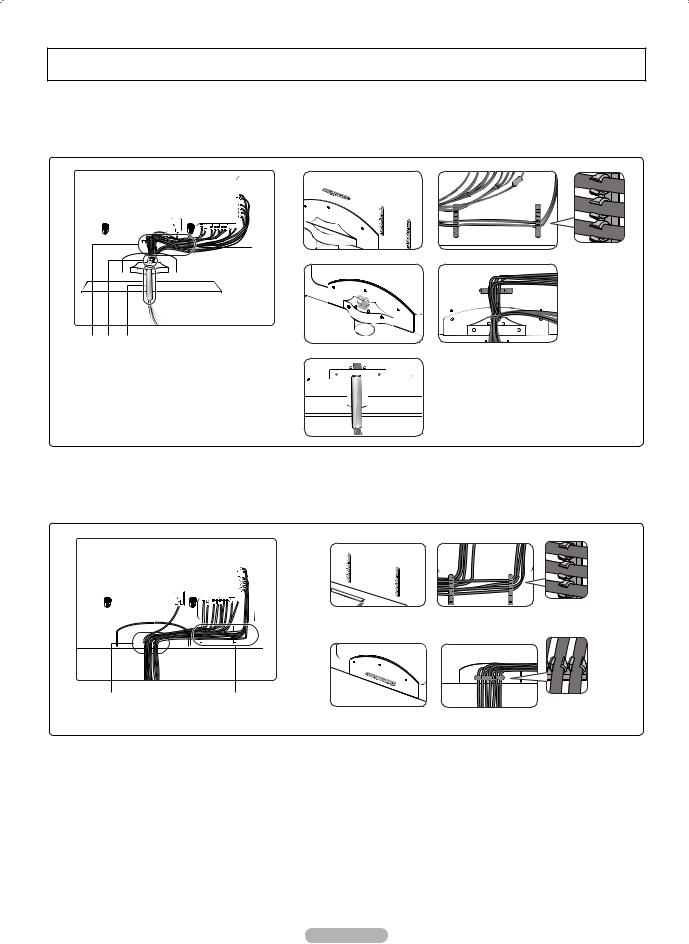
Assemblage des câbles
Insérez les câbles dans le serre-câbles de telle manière qu’ils ne soient pas visibles à travers le pied transparent.
N La couleur et la forme du produit peuvent varier en fonction du modèle.
Type support
1
2
1 2 3
3 

1 Serre-câble
2 Support du serre-câble
3 Serre-câbles
N Insérez les câbles dans le serre-câbles de telle manière qu’ils ne soient pas visibles à travers le pied transparent.
Type montage rural
1 
2
2 1
12 Serre-câble
Français -
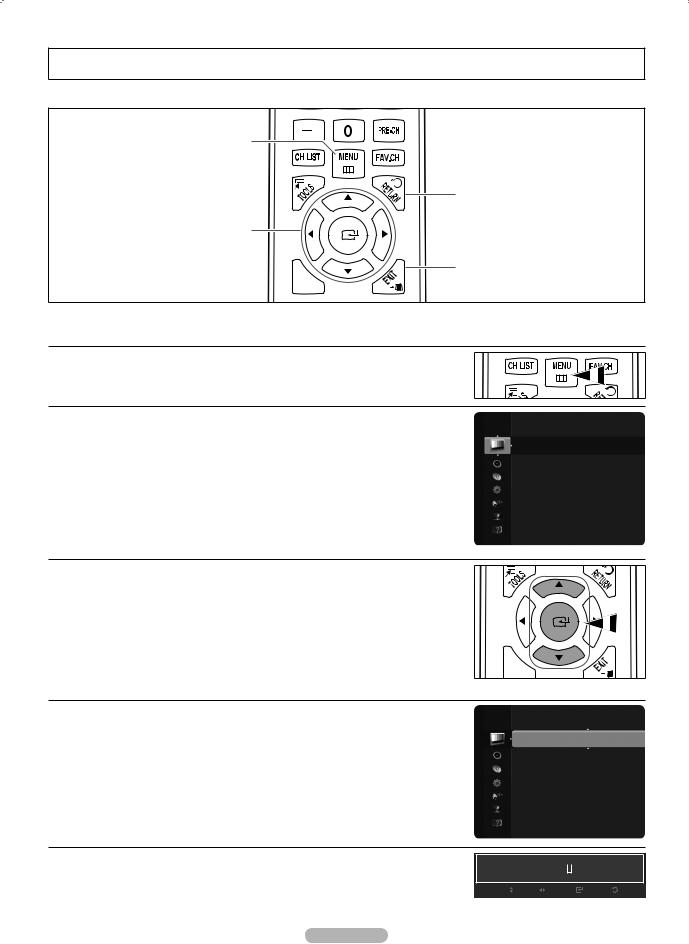
Affichage des menus
Avant d’utiliser le téléviseur, procédez comme suit pour apprendre à naviguer dans le menu afin de sélectionner et de régler les différentes fonctions.
Bouton MENU
Affiche le menu principal à l’écran.
▲/▼/◄/►/ Bouton ENTERE
Déplace le curseur pour sélectionner un élément. Valide l’élément actuellement sélectionné. Confirme un paramétrage.
IN T ERN @ E T
Bouton RETURN
Revient au menu précédent.
EXIT
Ferme le menu affiché à l’écran.
Maniement de l’affichage à l’écran
L’étape d’accès peut varier en fonction du menu sélectionné.
1.Appuyez sur le bouton MENU.
2.Le menu principal apparaît à l’écran. Plusieurs icônes s’affichent sur le côté gauche du menu :
Image, Son, Canal, Configuration, Entrée, Application, Assistance.
Picture
Mode |
: Standard |
Lum. Cellules |
: 4 |
Contraste : |
95 |
Luminosité |
: 45 |
Netteté |
: 50 |
Couleur |
: 50 |
Teinte (V/R) |
: V50 / R50 |
Paramètres avancés |
|
3. Appuyez sur le bouton ▲ ou ▼ pour sélectionner l’une des icônes.
4. Appuyez ensuite sur le bouton ENTERE pour accéder au sous-menu de l’icône.
IN T ERN @ E T
5. Appuyez sur le bouton ▲ ou ▼ pour sélectionner l’un des sous-menus de l’icône.
Picture
Lum. Cellules |
: 4 |
Contraste |
: 95 |
Luminosité |
: 45 |
Netteté |
: 50 |
Couleur |
: 50 |
Teinte (V/R) |
: V50 / R50 |
Paramètres avancés |
|
Options d’ image |
|
Réinitialisation de l’ image
6.Appuyez sur le bouton ◄ or ► pour diminuer ou augmenter la valeur de l’élément sélectionné. Les informations affichées à l’écran peuvent varier en fonction du menu sélectionné.
7.Appuyez sur le bouton ENTERE pour effectuer la configuration.
8.Appuyez sur le bouton EXIT pour quitter le menu.
▲
Luminosité 
 45
45
▼
Déplacer |
Régler |
Entrer |
Retour |
Français -
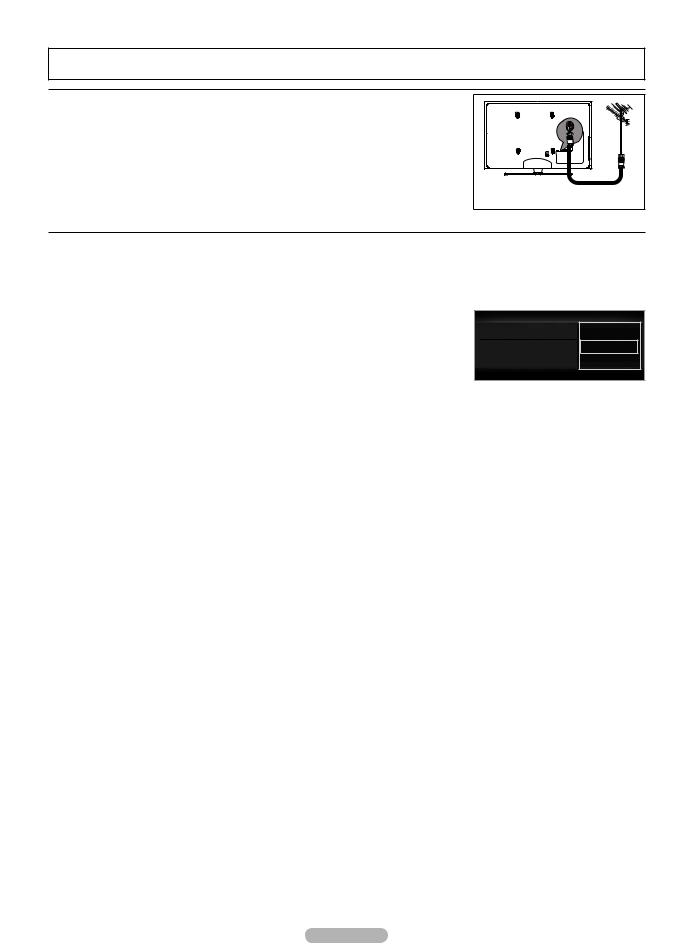
Plug & Play
Lorsque vous allumez le téléviseur pour la première fois, des réglages de base s’effectuent l’un après l’autre de manière automatique.
N Preset (Préréglage) : connexion du câble d’alimentation et de l’antenne.
Lorsque vous allumez le téléviseur pour la première fois, des réglages de base s’effectuent l’un après l’autre de manière automatique.
N L’écran de veille est activé si aucune touche de la télécommande n’est actionnée pendant plus
d’une minute lorsque le mode Plug & Play est en cours d’exécution.
N L’écran de veille est activé si aucun signal de fonctionnement n’est reçu pendant plus de 15 minutes.
N Si vous sélectionnez par erreur un pays incorrect pour votre téléviseur, il se peut que les |
Plug & Play |
||
caractères affichés à l’écran soient incorrects. |
SelecttheOSDLanguage |
Nederlands |
|
1. Appuyez sur le bouton POWER de la télécommande. Le menu Select the OSD Language. |
|||
MenuLanguage |
English |
||
s’affiche automatiquement. Sélectionnez la langue de votre choix en appuyant sur le bouton |
|||
|
Eesti |
||
▲ ou ▼. Appuyez sur le bouton ENTERE pour confirmer votre choix. |
|
||
|
U Move E Enter |
||
|
|
||
2.Appuyez sur le bouton ◄ or ► pour sélectionner Démo Magasinor Util. Domicile, puis appuyez sur le bouton ENTERE.
N Nous recommandons de régler le téléviseur sur le mode Util. Domicile pour une meilleure qualité d’image dans votre environnement personnel.
N Le mode Démo Magasin n’est prévu que pour un usage en magasin.
N Si l’unité est accidentellement définie sur le mode Démo Magasin et que vous souhaitez revenir au mode Util. Domicile (Standard) :Appuyez sur le bouton Volume du téléviseur. Lorsque l’OSD du volume s’affiche, appuyez pendant 5 secondes sur le bouton MENU du téléviseur.
3.Appuyez sur le bouton ENTERE.
Sélectionnez le pays approprié en appuyant sur le bouton ▲ ou ▼. Appuyez sur le bouton ENTERE pour confirmer votre choix.
4.Appuyez sur le bouton ▲ or ▼ pour mémoriser les chaînes de la connexion sélectionnée, puis sur le bouton ENTERE.
•Hertzien : signal d’antenne aérienne.
•Câble : signal d’antenne par câble.
5.Appuyez sur le bouton ▲ or ▼ pour sélectionner la source d’antenne à mémoriser. Appuyez sur le bouton ENTERE pour sélectionner Démarrer.
•Numérique et Analogique : chaînes numériques et analogiques.
•Numérique : chaînes numériques.
•Analogique : chaînes analogiques.
N La recherche de chaînes démarre et se termine automatiquement.
NPour une description plus détaillée de la sélection du mode Câble, reportez-vous au chapitre Mémorisation automatique.
6.Le message Définit le mode Horloge apparaît.
Appuyez sur le bouton ENTERE.
Appuyez sur le bouton ▲ or ▼ pour sélectionner Auto., puis appuyez sur le bouton ENTERE.
NSi vous sélectionnez Manuel, le message Définit la date et l’heure s’affiche.
(Pour une description plus détaillée de la fonction Manuel, reportez-vous au chapitre Réglage de l’heure)
NSi vous avez reçu un signal numérique, l’heure sera automatiquement réglée.
7.Les brèves instructions sur la façon d’obtenir les meilleures performances de votre nouveau téléviseur HD s’affichent. Appuyez sur le bouton ENTERE.
Ce menu est disponible dans Guide de connexion HD dans le menu Assistance.
8.Le message Profitez de votre téléviseur. s’affiche.
Lorsque vous avez terminé, appuyez sur le bouton ENTERE.
Si vous souhaitez réinitialiser cette fonction...
1.Appuyez sur le bouton MENU pour afficher le menu. Appuyez sur le bouton ▲ ou▼ pour sélectionner Configuration, puis sur le bouton
ENTERE.
2.Appuyez de nouveau sur le bouton ENTERE pour sélectionner Plug & Play.
3.Entrez votre code PIN à quatre chiffres. Le code PIN par défaut d’un nouveau téléviseur est “0-0-0-0”. N Si vous souhaitez changer le code PIN, reportez-vous au chapitre Modifier PIN.
N La fonction Plug & Play est uniquement disponible en mode TV.
Français -

Sélection de la source
Appuyez sur le bouton SOURCE de la télécommande. Vous pouvez sélectionner le mode TV ou une source d’entrée connectée au téléviseur. Ce bouton permet de sélectionner la source d’entrée que vous souhaitez regarder.
N TV, Ext.1, Ext.2, AV, Composant, PC, HDMI1/DVI, HDMI2, HDMI3, HDMI4, USB.
N Pour plus d'informations, consultez le manuel électronique.
[N*a
Nzx{z~ly
PLa9<= E*8*8*8*8
***]lq}lùnst} T*Z tw~
Réglage de la taille de l'écran
Si vous souhaitez modifier la taille de l’image à l’écran. Appuyez sur le bouton MENU pour afficher le menu. Vous pouvez sélectionner la taille de l’image en sélectionnant Image → Options d’image → Format. Appuyez sur le bouton ▲ ou ▼ pour sélectionner le format d’écran souhaité. (16 :9 / Zoom1 / Zoom 2 / Ajuster à l'écran / 4:3 / Just Scan (Scan uniquement))
O Vous pouvez également appuyer sur le bouton P.SIZE de la télécommande de façon répétée pour modifier la taille de l’image.
Options d’image
|
|
|
|
Nuance Coul. |
: Normal |
|
|
|
|
|
|
||
|
|
|
|
Format |
: 16:9 |
|
|
|
|
|
Mode écran |
: 16:9 |
|
|
|
|
|
NR numérique |
: Auto. |
|
|
|
|
||||
|
|
|
|
Niv. noir HDMI |
: Normal |
|
|
|
|
|
1080 Full HD Motion Demo |
: Arrêt |
|
|
|
|
|
Mode Film |
: Arrêt |
|
|
|
|
|
▼ |
E Entrer R Retour |
|
|
|
|
|
U Dépl. |
||
Français -
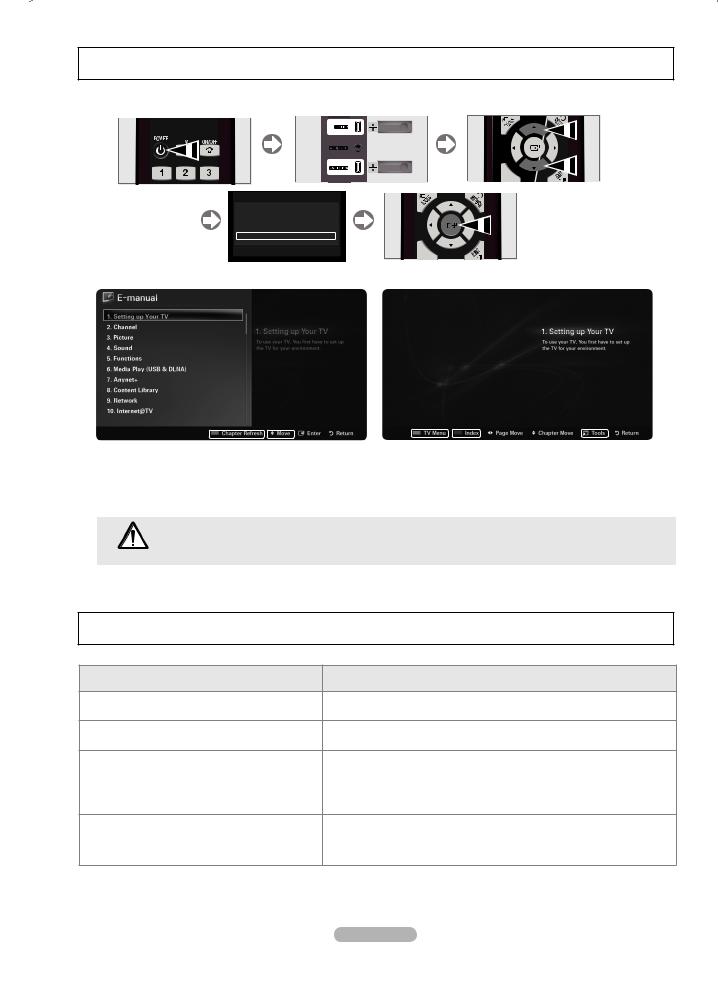
Installation de la clé USB pour afficher le manuel électronique
Affichage des menus
Conn.aupériphériqueportable
Nouveaupériphériqueportableconnecté.
Périph.:MemoRive
MediaPlay
Bibliothèquedecontenu
Manuelélectronique
Miseàniveaudulogiciel
UDépl. EEntrer RRetour
Affichage
1 2
IN T ER @N ET
IN T ER @N ET
3 |
4 |
5 |
1. |
Rafraîchissez la fenêtre du chapitre |
3. |
Accédez au menu à l’écran du téléviseur. |
2. |
Accédez au menu sélectionné. |
4. |
Utilisez le menu d’index |
|
|
5. |
Affichez le manuel électronique. |
Attention : N’utiliser la clé USB que pour le manuel électronique
Toute utilisation dans un autre but risque de provoquer un dysfonctionnement.
Attention
Dépannage
Problème |
Solution |
Le manuel électronique ne se lance pas rapidement Vérifiez si la clé USB est correctement branchée au téléviseur.
Le manuel de la clé USB a été effacé |
Consultez le site www.samsung.com |
Vérifiez que le cordon d’alimentation est branché sur une prise secteur.
Aucune image ni aucun son Vérifiez que vous avez appuyé sur le bouton de marche/arrêt du téléviseur. Vérifiez les réglages de contraste et de luminosité.
Vérifiez le volume.
Vérifiez le volume.
Image normale, mais aucun son Vérifiez si le bouton MUTEM de la télécommande a été actionné.
Vérifiez les paramètres Sélection du haut-parleur.
Français -
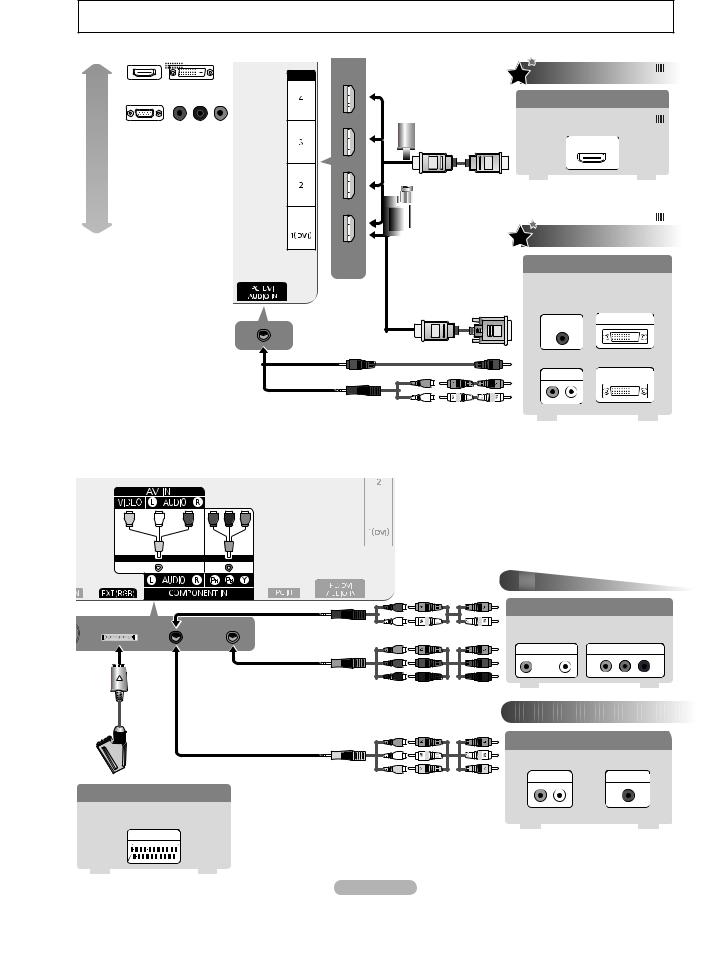
Branchement d’un appareil AV
Mieux
Normal
/ |
HDMI IN |
Connexion HD |
HDMI/DVI |
|
Utilisation d’un câble HDMI |
/ |
|
|
|
DVD / lecteur Blu-Ray / décodeur câble / |
|
PC/COMPONENT |
|
récepteur satellite (boîtier externe) |
|
|
HDMI OUT |
EXT/VIDEO
Connexion HD
Câble HDMI/DVI
DVD / lecteur Blu-Ray / décodeur câble HD / récepteur satellite HD (boîtier externe)
AUDIO OUT DVI OUT
|
or |
AUDIO OUT |
DVI OUT |
B |
B |
G |
G |
Connexion à composantes
Utilisatoin d’un câble composante
DVD / lecteur Blu-Ray / décodeur câble / récepteur satellite
AUDIO OUT |
COMPONENT OUT |
Connexion audio/video
Câble audio/vidéo
Magnétoscope
AUDIO OUT |
VIDEO OUT |
Câble Scart
VCR / DVD
EXT
Français -

Branchement d’un appareil audio
Mieux
Normal
OPTIQUE (Numérique)
AUDIO (Analogique)
 Connexion audio numérique
Connexion audio numérique
Utilisation d’un câble optique
Système audio numérique
OPTICAL
Branchement d’un PC
Connexion HD
Câble HDMI
HDMI OUT
Connexion HD
Utilisation d’un câble HDMI/DVI
AUDIO OUT |
DVI OUT |
Câble D-Sub
AUDIO OUT |
PC OUT |
Français - 10
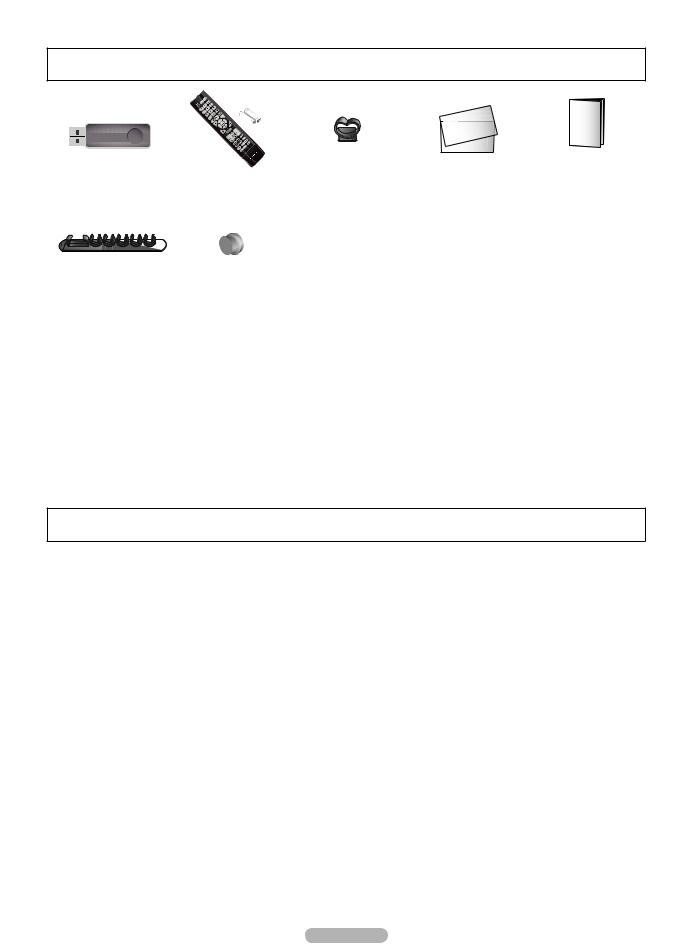
Mitgeliefertes Zubehör
USB (Elektronisches Handbuch) |
Fernbedienung / AAA- |
Standfuß mit Kabelhalter |
Garantiekarte/ |
Kurzanleitung zur Konfiguration |
|||||
|
|
|
|
Batterien (2 Stück) |
|
|
|
Handbuch mit |
|
|
|
|
|
|
|
|
|
Sicherheitshinweisen |
|
|
|
|
|
|
|
|
|
(nicht überall verfügbar) |
|
|
|
|
|
|
|
|
|
|
|
|
|
|
|
|
|
|
|
|
|
|
|
|
|
|
|
|
|
|
|
|
|
|
|
|
|
|
|
|
|
Kabelhalter (3 Stück) |
Haltering (4 Stück) |
Software-CD |
Reinigungstuch |
Kabelschlauch |
Verlängerungskabel |
Komponentenkabel |
AV-Kabel |
Untere Abdeckung |
Untere Abdeckung / |
|
|
|
(PS50B850 nur) |
Schrauben (PS58B850 nur) |
|
|
|
|
|
|
|
|
|
|
|
|
|
|
|
|
|
|
|
|
Schrauben (5Stück) |
Ferritkern (4 Stück) |
||||||||
(PS50B850 nur) |
(3301-001305) |
||||||||
Batterien in die Fernbedienung einsetzen
Vorbereitung für die Befestigung der Wandhalterung an der Wand
Fall A. Installieren der SAMSUNGWandhalterung |
Fall B. Installieren der Wandhalterung eines anderen Anbieters |
1.Befestigen Sie die Wandhalterung mit einemAnzugsmoment von maximal 15kgf·cm. Denken Sie daran, dass Bauteile bei einem höheren Anzugsmoment beschädigt werden können.
2.Zum Zubehörsatz gehört ein Haltering [2] zum Befestigen der Wandhalterungen von Drittanbietern am Samsung-Fernseher. (Fall B) Drehen Sie die Schrauben bis zum Anschlag in die Bohrung [1], wenn Sie die Wandhalterung an der Wand Anbringen.
Deutsch -
